#also working on some other themes/motifs meanwhile
Text
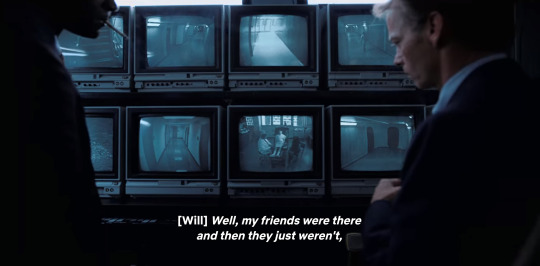
real vs fake, part 2 (season 2)
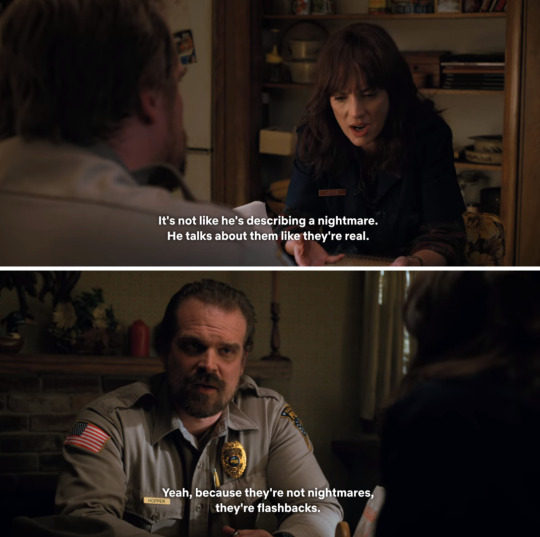
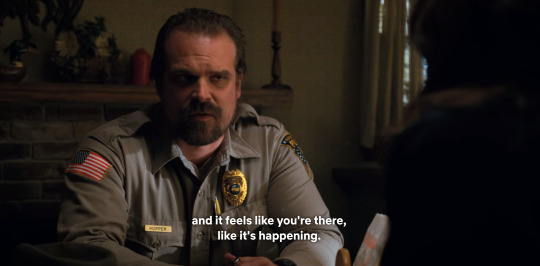
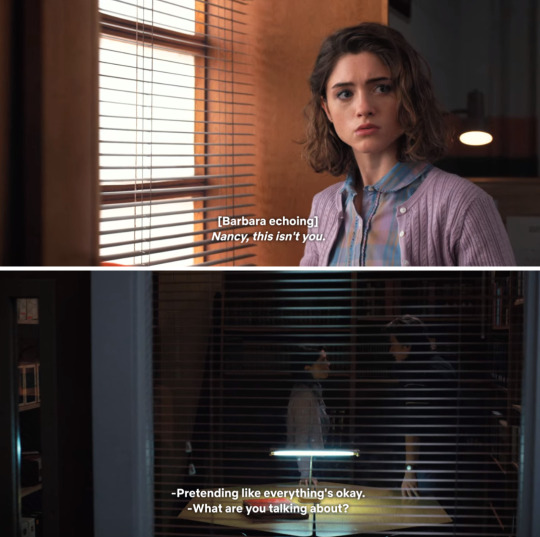
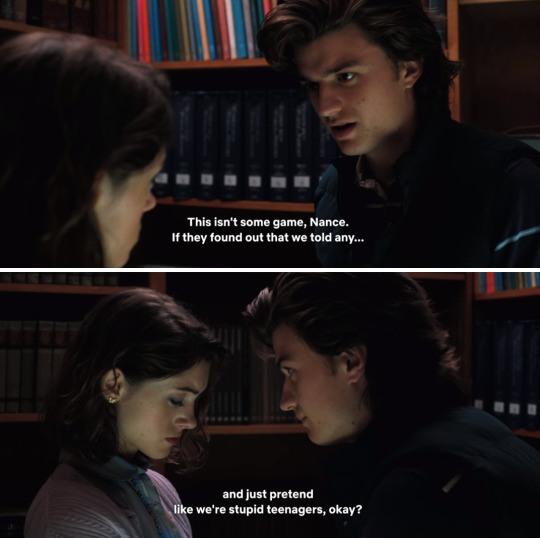
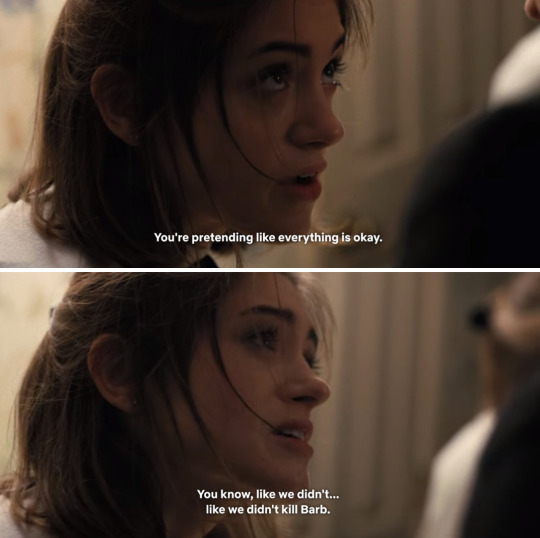

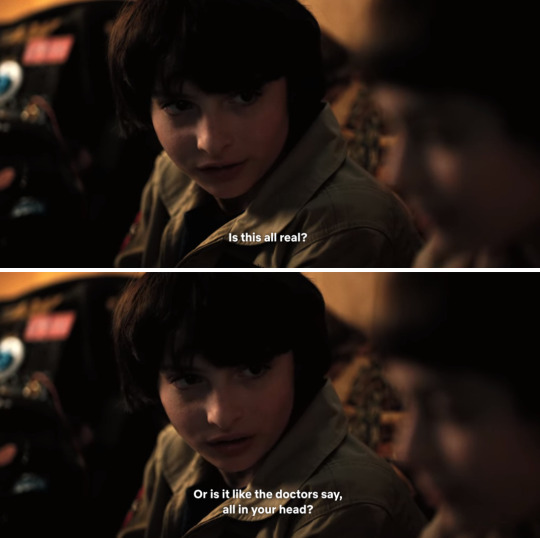

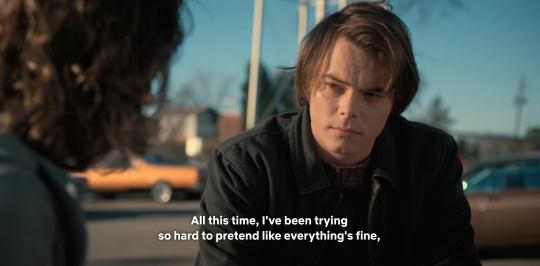
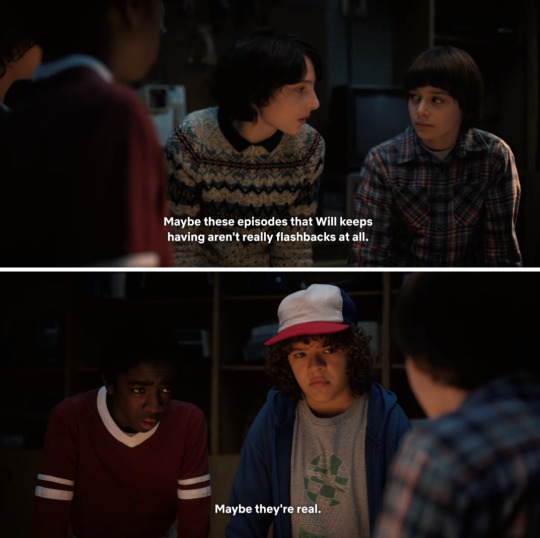
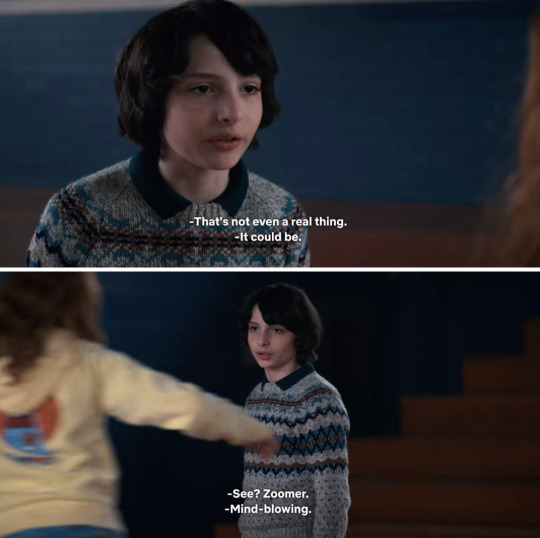

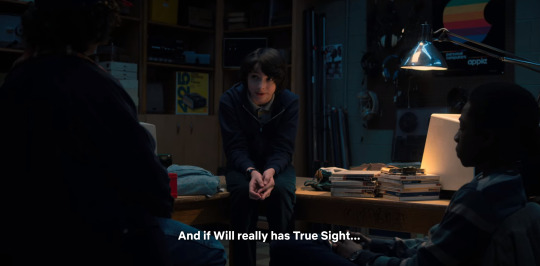
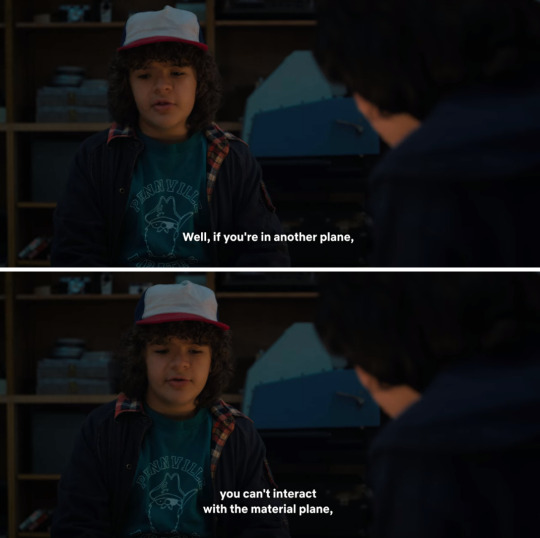
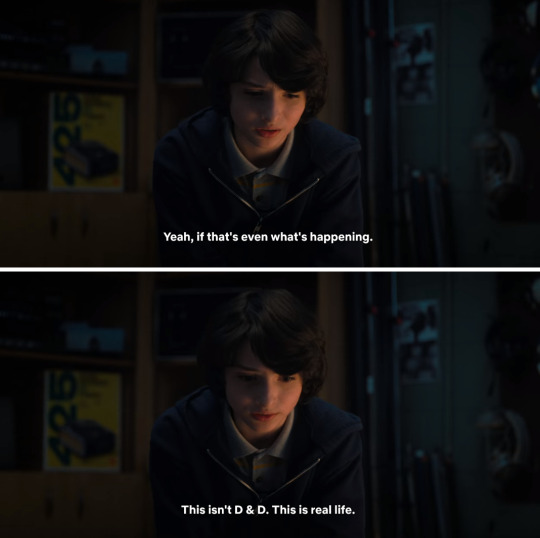

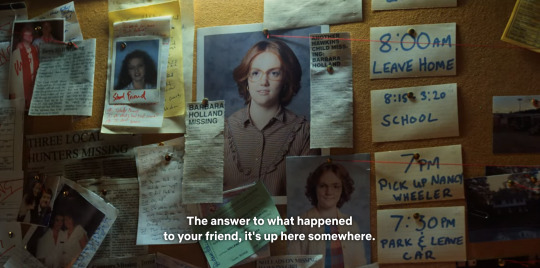
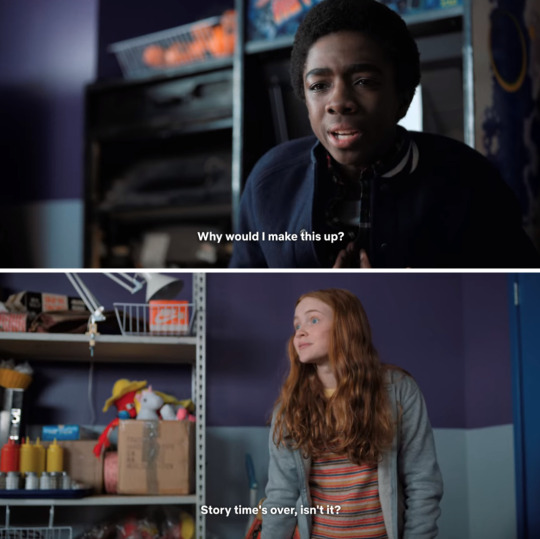
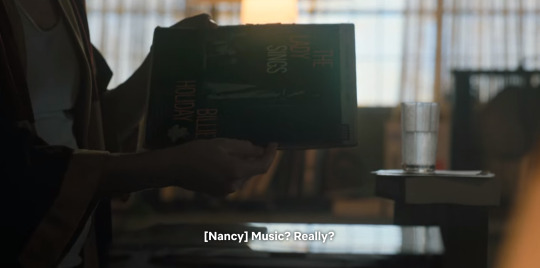


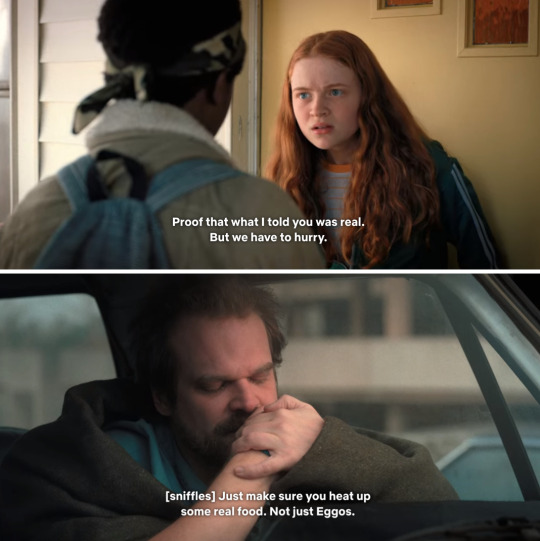

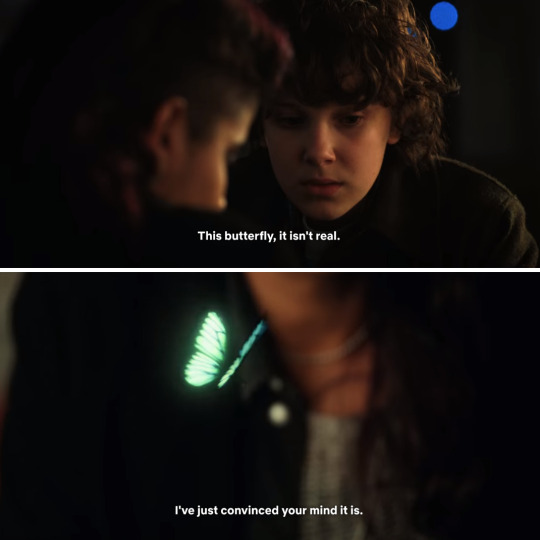
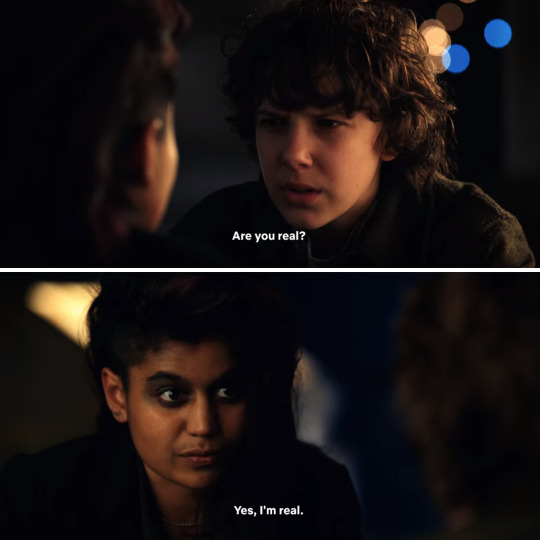
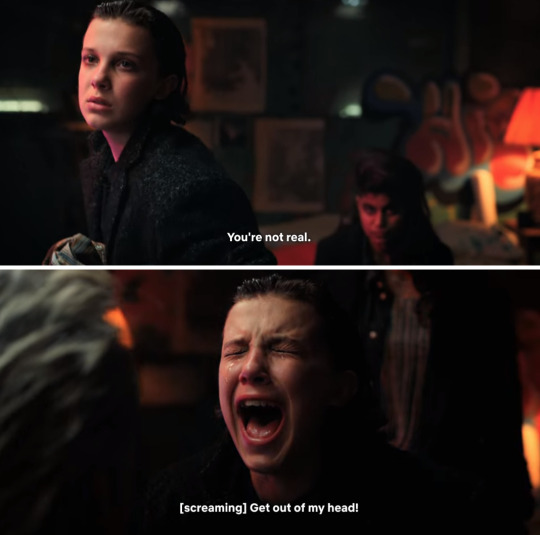

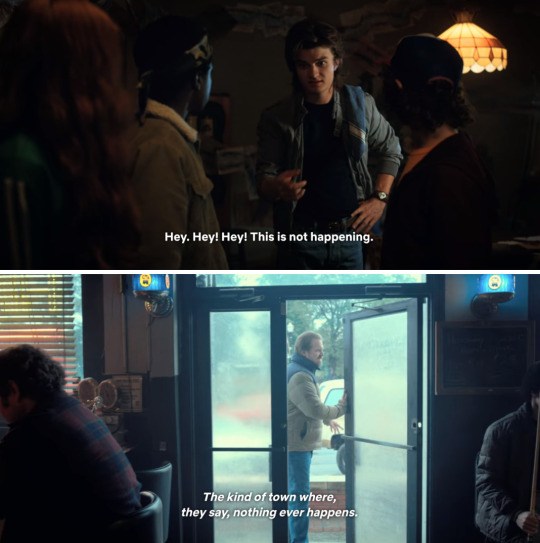
#there's. so much more to this but i need to make other compilations that tie in... dreams/nightmares and seeing/believing#the word 'gone'....here and there........#truth and lies and trust#memory and time GOD#something is going on#there's just SO MUCH that it's hard to analyze in full..... glad there are folks out there attempting it though#*me fighting with myself not to include every single time a character says really*.............. but what if..................#stretching the absolute limits of how many screenshots i can fit in one post#i have a feeling i'm gonna have to actually split s4 into two#s3-4 coming eventually but i still need to comb s3 in full so it might take a while#also working on some other themes/motifs meanwhile#mikesbasementbeets posts#compilations
25 notes
·
View notes
Text
thoughts, again, of the pathologic 2 soundtrack.
Genuinely one of the best soundtracks of a video game that I have ever heard, and also one of very few game soundtracks to use the noble prepared piano (including in River of Flegm, and also as the melody of Young Vlad's Shack Music). I have a Master's in what essentially amounts to Knowing About Music And Music History and it struck me that the P2 soundtrack does some genuinely very interesting things with essentially "making" an entire fictional culture's musical history using bits of real, pre-existing musicology.
The game's animal based mythology mostly centres around bulls but it's set in a region which places a lot of value on horses, and which has music that makes reference to The Gaits Of The Horse. To make its own version of that, the Pathologic Soundtrack uses the sounds that cattle make (most obviously with the voice imitating a cow lowing in Song to Boddho, which you hear when Artemy finds out that his father died in Day 1).
Meanwhile Scorn2, which you hear in the Abattoir, also uses not just pitch-shifted cattle sounds but pitch-shifted sounds of industrial meat-processing equipment. It is undeniably really eerie but it also works like... unsettlingly well with the general themes and narrative of that part of the game. It also meshes well with the other Plague Music (particularly Mad Mother Earth, which you only hear the beginning of when you meet the Rat Prophet), which takes one of the traditional elements of the soundtrack (the drum motif for Mad Mother Earth, the Cow Sounds for Scorn2) and twists and distorts it.
86 notes
·
View notes
Text
Kira Is Near's Watari AU

"Light Yagami is 17 years old when he stumbles on a cursed notebook and begins committing his first unwilling murders.
Nate River is 6 years old when he discovers a bounty of 30 million dollars on the supposedly normal and respectable son of the Chief of the NPA.
These two facts somehow end up in Light Yagami shot in half a dozen places in a dirty warehouse a week later, Near dragging his body out of there, and both simultaneously disappearing into thin air.
Well, at least until six years later, when criminals begin dying in the masses from heart attacks. With a new Death Note user on the loose, Detective Near and his capable butler and caretaker, Kira, are on the case.
With tensions high between them and the NPA, Near and Light will be forced to confront just what happened that week, half a decade ago.
OR, my Kira is Near's Watari AU"
(Taken from a draft summary of a 5 part WIP fic)
-
So, I've read Noel Verse (TzviaAriella) and Pale Moon (KaedeRavensdale) on Ao3, watched some Black Butler, among some other fanfic, pinterest fanart, and more media with Butlery themes... and now I've got some serious brain rot.
I mean, like, the aesthetic is amazing. And it's doubly hilarious if L and Watari ever meet Near and Kira in this universe because they're total and complete opposites. Visually wise, at least, with Near's white motif and Light's signature beige suits with a splash of red with his tie, their workspace always very modern and minimal. Then Watari's cloaked in all black with L being... L, surrounded by more of an old money setting. Opposite spectrums of ridiculous. Especially if the task force meets these two detective teams and they'd just be... so incredulous. And the angst of Light and Soichiro reuniting.
Also, just the idea of genius, perfect, most promising student of Japan, Light Yagami, showing back up as a butler/caretaker/spy/hitman working for the mysterious yet infamous Detective Near. Only for that detective to turn out to be a 12 year old kid playing with his toys, who Light seriously treats as his boss without an ounce of irony. Everyone just gets more dumbfounded once said kid starts pulling genius deductions out of thin air and controlling black ops. While Light is sent either on said black ops, or to get a certain toy set for Near. No in between.
I imagine Light would still very much have blood on his hands, willing and unwilling, and would be loyal to Near and unwilling to part with him. Partly out of his own self interests and partly out of a genuine sense of repaying the debt for saving his life. Meanwhile, Near is content to have someone reliable on his side who doesn't underestimate him or treat him any differently for his age, nor intends to use him for another agenda. Whatever Near asks, Light does.
And maybe, just maybe, there would be hints of some other influence. Something ingrained in them, not quite dreams nor memories, that draw the two together. But surely this is the first time they've done all this?
-
Alright, is that enough ranting about a fic I probably don't have time to write? Yeah, I think so. XD
Oh well, at least I got to make these doodles today. :)
#fanart#fanfic#death note#light yagami#kira#nate river#near#death note fanart#death note fanfiction#kira is near's watari au
84 notes
·
View notes
Text
I caught up with my re-watch of the second episode of Rings of Power! The episodes are long and have a lot going on, but it was fun and enjoyable—more than the first, actually, since it wasn't trying as hard to introduce everything and could breathe more.
I really liked the beginning with Galadriel in the sea, staring up at the stars before she starts swimming. Very apropos.
I thought Nori et al's stuff would be kind of tedious (I've never been super into hobbits or proto-hobbits), but tbh I find everything about it delightful to watch.
Arondir and Bronwyn are maybe the prettiest onscreen pairing I've ever witnessed. Their little theme/motif is also really nice and not overwrought the way the music sometimes got in the first episode. It suits my sense of their story being a bit like marginalia that doesn't exactly fit into the grand sweeping main narrative of Middle-earth, but is getting some spotlight anyway.
And now we've got Celebrimbor for real, with warning bells all over him! (Not literally.) I appreciate that almost the first thing he does is mention Fëanor, and he and Elrond immediately dive into a conversation about the Silmarils and craftsmanship, and Elrond seems deeply ambivalent off the bat. Him saying "So much beauty, and so much pain" about them/Fëanor's craftsmanship while wearing a feathery outfit that is hard not to associate with Elwing is ... yeah. You'd know, Elrond.
Celebrimbor's slightly snarky explanation that he asked for a massive team to build his tower forge thing and Gil-galad "has sent me you, instead" kind of worked for me? Robert Aramayo doesn't look anything like my idea of Elrond but I love his difficult-to-pin-down yet determinedly pleasant performance of Elrond's emotions and mannerisms. I also like Celebrimbor's robes.
And, oh man, seeing Khazad-dûm in its heyday? HELL, YEAH. The music is doing some of the lifting but mostly it's just fucking awesome to see. The show is clearly lingering on it with a lot of love and attention, which it's really nice to see the dwarves getting.
I liked getting references to Aulë from the dwarves (no, it's not what dwarves would ordinarily call him, but it's a reasonable concession to comprehensibility for people who aren't, well, us). During the whole challenge thing, Elrond is referred to as an Elf over and over and over, which I'm kind of :\ about as a firm proponent of Half-Elves Are Not Men or Elves, No Matter What Ultimate Fate They Chose. Elrond seems pretty uncomfortable with it (though that may be more about his relationship with Durin), but also does more or less accept it as a descriptor.
Nori was still trying to figure out the Stranger, which somehow is not boring, and meanwhile her father's ankle breaks or sprains or something as part of festival preparations. The Harfoots collectively treat this as a huge deal and are asking if he'll be able to migrate, which is not exactly framed as super ominous, but definitely seems significant and at least somewhat ominous. Nori is clearly pretty freaked out.
The first part of the episode is sadly a bit sparse on my girl Galadriel (though she got so much attention in the first episode that it's understandable), but we got back to her, still swimming. It'd be a bit unbelievably impressive from other people, but I can believe it for her. She sees the raft of survivors before we do, which I liked as a little detail.
The raft is really spiky, appropriately enough for a raft with Sauron on it. It's kind of hilarious that almost his first line is "Looks can be deceiving." No shit, lmao.
The survivors+"Halbrand" and Galadriel have this brief and slightly weird interchange about Corsairs, which strikes me as an odd reference both geographically and in the time period we're in.
Then there's a SEA WYRM that shows up out of basically nowhere and causes havoc resulting in the deaths of everyone except Sauron Halbrand and Galadriel. A coincidence, I'm sure.
Then we cut back to Elrond and Durin, and finally find out why Durin is so mad at Elrond. It turns out that Elrond basically ignored his existence for 20 years while he was doing ... things, and Elrond didn't even realize it'd been so much time because a couple decades is nbd to him. Angst and other difficulties around different lifespans = one of my most favorite fantasy tropes, so I'm onboard for this particular drama.
It's a little surprising that Elrond of all people would make this mistake, but then again, Elros himself lived so long that 20 years would have been a tiny fraction of his own lifetime, too. (Now I want lifespan angst or anxiety or something with Elros being the one who's "welp, it's really been that long?")
Anyway, I enjoyed how serious and fraught the whole discussion is and then the cut to comedy when Elrond arrives to apologize to Durin's wife, Disa. IDK, I didn't feel it was undercutting Durin as a character or his feelings, even while poking a bit of fun at his sulkiness—e.g., when Disa enthusiastically tells Elrond to make himself comfortable, and Durin is like, "But not too comfortable."
I love Disa's appearance, by and large. The patterning on her outfit is so cool and different. She's generally a delightful character, and I appreciate that while there's an element of calculation to what Elrond is doing, he seems genuinely interested in her and her work. The narrative itself feels really interested in the dwarves and their culture at this point, and I just enjoyed that a lot.
Meanwhile, back to Galadriel and Halbrand/Sauron. It's still really funny to me that there was so much indignation over Eminem Sauron being insufficiently hot, and then actual Sauron turned out to be this currently bedraggled but very conventionally attractive guy.
I like his little head tilt as he's ostensibly figuring out what's going on and his little "You're a deserter, aren't you?" As if he doesn't know who Galadriel is, hah.
When he says "My people have no king," it feels like a pretty blatant call-back to Boromir in Jackson's FOTR, but of course it's inverted, ultimately. Halbrand is a shadow Aragorn, not a shadow Boromir, and is himself (supposedly) the king he's rejecting. I'm not going to go on too much about it because I have a whole post about it here.
Anyway, Galadriel condescending to Sauron is kind of delightful. Sure, she's mistaken in assuming he's mortal. But everyone should condescend to Sauron, actually!
Back to Bronwyn, who is a bit more interesting in this episode, she actually makes it home and tries to convince her village that something is very wrong, but no one believes her. They seem kind of ridiculously stupid, tbh? Maybe not ridiculously—I can believe they would actually respond that way (I lived in the shadow of Mt St Helens for years, I know very well that historically sometimes that's the response to clear warnings of disaster). But come on, people.
Then there's Arondir in the horrifying claustrophobic tunnels with the glimpses of horrific claws. It is very successfully claustrophobic, especially when MICE start running all over him as they're trying to escape. Agh, the special hell. Then he emerges in a pool of water, only the water is super gross also, and he's focusing on the bubbles of something pursuing him only to get grabbed by a different claw monster.
We don't see him again for the entire rest of the episode and that's alarming!
I was taking little notes while I was watching, but at this point that got interrupted and I ended up watching the rest of the episode with other people and didn't take notes. But general thoughts:
Durin's final change of heart wrt Elrond and decision to take Elrond's offer to his father was a bit oddly offscreen, and it's kind of needlessly mysterious about what advantage the dwarves have over the Elves, but the show has already given us enough through both exposition and the behavior of the characters that it's not hard to buy.
Sauron saving Galadriel with Finrod's dagger is like. Hmm. Well. Yeah, that's a lot. I really like the scene of their raft in the storm—not much actually happens apart from it looking cool, but it did look really cool! And I love the imagery of Sauron desperately trying not to be drowned by the wrath of the sea, aka what will actually happen to him! :)))
I love how mysterious the Stranger is and basically everything that Nori and Poppy choose to be. Things like Poppy's "I don't speak firefly!" just work much better for my personal sense of humor than ... like, dwarf-tossing.
Theo's whole deal with the sword is ... menacing in a way where we know enough to know something is Very Wrong and related to Sauron, but not really what's going on with it. And the thing Bronwyn and Theo fought and killed was super freaky. I liked the abrupt cut to Bronwyn showing the decapitated head to the stupid villagers and them being like, "hmm. okay, guess we're moving now."
Aaaand Galadriel and "Halbrand" have been discovered!
#anghraine babbles#tv: lotr#legendarium blogging#long post#elanor brandyfoot#poppy proudfellow#arondir#bronwyn#my little piano: music is magic#celebrimbor#elrond#durin iv#galadriel#elros tar minyatur#disa#sauron#legendarium fanwank#theo#rings of power
22 notes
·
View notes
Text
GUYS I'VE OFFICIALLY LOST IT-
So. Awhile ago, I saw this post, right? Basically it just said that Sera and Sir Pentious' cards have very similar compositions, and that Seraphim, which is what Sera is, are often associated with serpents. Interesting, but could still be a coincidence, right?
So anyways I checked the reblogs and saw somebody say they should kiss. And now I'm insane.
Because like... the only thing we know really about Sir Pentious' potential story arc in the show is that he's gonna have a crush on one of the other characters. And the only thing confirmed about his sexuality(to my knowledge) is that he is attracted to women. We don't really have any way to know who his crush is, because there are a lot of women in Hazbin Hotel, but could still be noteworthy, right? And like... okay this is gonna sound like the most "trust me, bro" evidence I could possibly pull out of my ass at first but I just need you to hear me out here, okay? Sera's crown and Sir Pentious' hat have a lot of visual similarities. Here's a helpful diagram :)
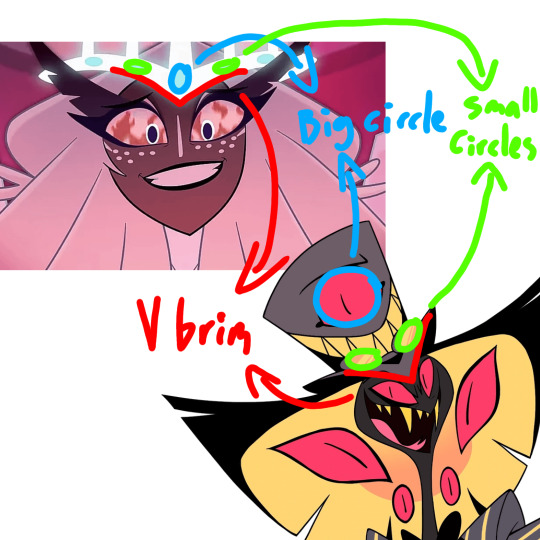
Which like. Okay. Could literally be nothing, right? Except for two small things that I can't let go of: One, Sir Pentious' goggles + the v-shaped brim on his hat were added to his design AFTER he was given a more prominent role in the show-
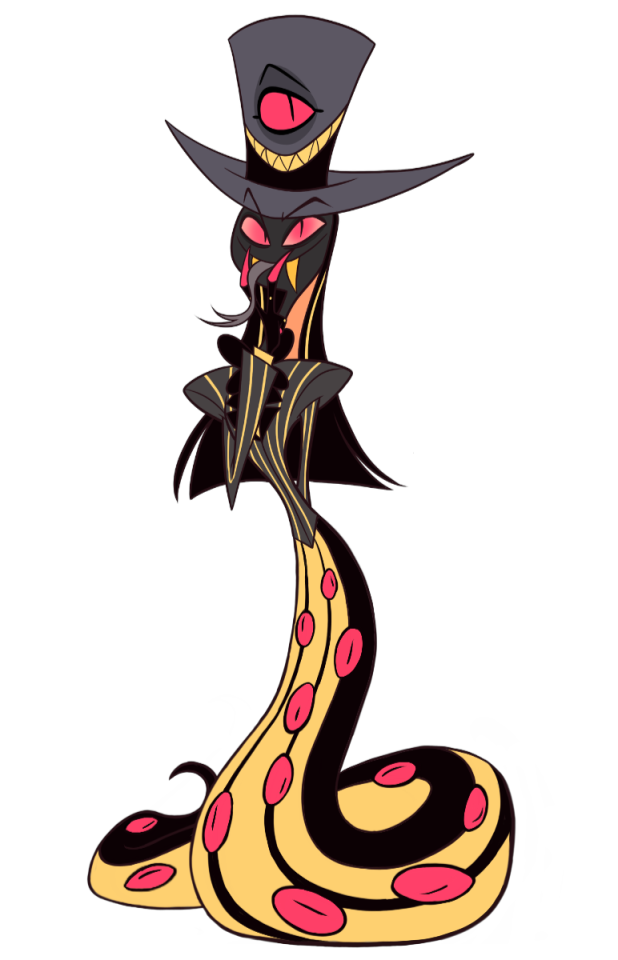
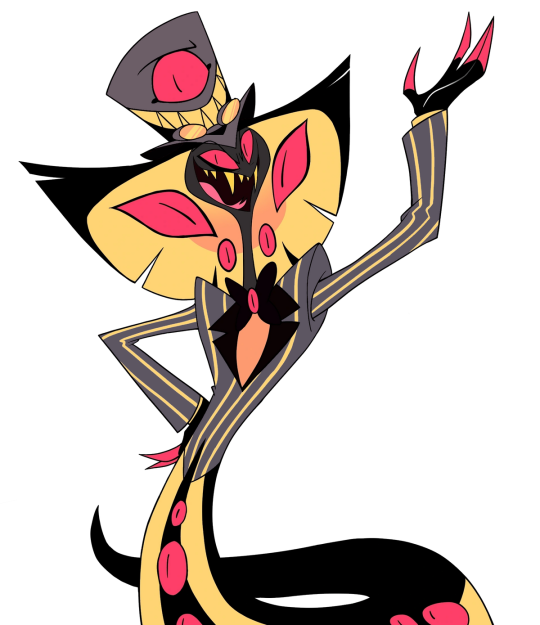
(Pilot design, back when he was meant to be a one-off villain of the week vs current design as a member of the main cast)
And two, the Hellaverse shows kind of have a tendancy to use visuals in order to signify characters' relationships to eachother. It's also just a pretty popular form of symbolism as a whole tbh, but the Hellaverse has a lot of really good examples. Like, for instance, how Vaggie's new outfit is a lot closer to Charlie's color pallette than any of her previous designs, or this really good breakdown by @/raeynbowboi about the symbolism of hearts in Hazbin Hotel and how they pertain to Angel Dust/his relationships! It's from awhile ago so some of the info is a tad outdated, but overall I do think the analysis holds up. Meanwhile, in Helluva Boss, Moxxie and Millie have basically the same color pallette and they were the most functional relationship in the entire show before before Fizzmodeus came along. Which, speaking of those two...

See, I made this diagram because, after I pointed out the similarities between Sera and Sir Pentious' headgear to my dad and asked him if those kinds of similarities were a valid form of analysis(because I am but a humble highschooler that doesn't know everything about media analysis, and also I felt like I was losing my mind-), my dad said that I should look at the creator's(Vivziepop's) other works to see if couples having similar motifs was a recurring theme. So obviously, I picked my favorite couple in either show and disected their designs for every little detail that could maybe possibly be an intentional parallel. And while some of it is kind of iffy, like Fizz's limbs being the same kind of blue as Ozzie's tufts could just be a way to show that Ozzie made them, or both of them having uh, two things sticking off of their head(that one's definitely a reach-), I think stuff like both of them having hearts as a recurring detail in their designs or having lITERALLY THE SAME EYE COLOR??? Are pretty good evidence that Viv/the Hellaverse design team tend to use visuals to signify characters relationships.
ALSO!!!! If the Fallen Angel Vaggie theory ends up being true, there could be some interesting parallels to draw between Chaggie and Sera/Sir Pentious! Something about like... demon royalty/random angel vs angel royalty/random demon. Could be used to draw parallels between how the two societies treat that kind of thing idk.
So, now that all the meta evidence is out of the way, we can get down to what really matters: would these two work as a couple? Do their personalities mesh well togther? And the answer to that is!
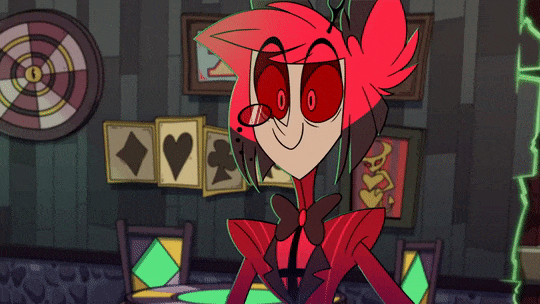
IM SORRY FOR USING THE GIF IT WAS A GOOD JOKE IN MY HEAD BUT TYPING THIS OUT IDK IF IT'S ACTUALLY FUNNY-
But in all seriousness, I don't actually know. We just... haven't seen enough of Sera to know for sure. In fact, this whole theory is based off of small details that definitely add up to SOMETHING, but could very well be pieces to some very different puzzles that I'm trying to shove together because somebody jokingly suggested that they would fit. Like, the parallels really COULD mean something, and it COULD have something to do with Sir Pentious having a crush on another character, but like. There could also be a million other answers to both of those questions, y'know? I also have a tendancy to make wild conspiracy theories about genuinely inconsequential details... I almost never talk about them publically, but still. Though I will say, based off of Sera's description in the leaks, I could definitely see a world where she bounces off of Sir Pentious pretty well. Her description in the leaks very much gave me uh... Isabela cover of Surface Pressure vibes, y'know? Shit that is- that is a weird way to describe that but most people on here have seen Encanto right? Y'all get it? And Sir Pentious is both a Victorian Gentleman Type and completely unhinged. Like... idk there's something there. I could maybe see it working. But at the end of the day, it's just too early to tell.
That being said I WILL be trying to pump out some fanart of these two before the actual show comes out and crushes my crackshipping dreams. Also their ship name is either SeraPentious or PentSera I can't decide.
Edit: Wait a second... SeraPent. Serpent. PUN!!!!!!!!!! Okay I think I'm going with SeraPent-
#this is really just my attempt to make PentSera a thing before the show airs and I look like a fool#CRACKSHIPPERS ARIIIIIIIISE!!!!!!!!!#hazbin hotel#hazbin hotel analysis#idk if that's actually a tag but who cares#sera#hazbin sera#hazbin hotel sera#sir pentious#sir pentious x sera#sera x sir pentious#serapentious#pentsera#I might just stick with pentsera tbh it rolls off the tongue way better#analysis#long post#I feel like. I should tag this with late night ramblings. this feels like a late night ramblings post.#probably because I'm sleep deprived and so depressed I'm constantly exhausted#I'll tag late night ramblings for now and remove it if I change my mind ig#late night ramblings#serapent#gal overanalyzes random shit
25 notes
·
View notes
Text
I only got to join about halfway through the clown princess drawing stream yesterday, so I was listening back to the beginning of the VOD, and um? They played a new track from the Pristine Cut? Can we talk about this??
youtube
(Discussion on the track begins at 20:08, track starts at 21:06)
It's got a great orchestral sound with lots of woodwinds, which reminds me a lot of the Damsel's themes. There's also a sense of warmth to it that makes me think of A Kiss from a Thorn, and even of The Unknown Together. It's a really pretty track.
What really fascinates me about it though is how it inverts the main Princess motif in a pretty unique way. Instead of the usual rising arpeggios in the piano, there's falling arpeggios, which are heard throughout the track. The four-note tune in the flute is a variant of the main Princess motif played in reverse.
It took me a while to figure out what the melody played on the cello(?) is based on, but it's actually the second half of the Princess theme, reversed and played in equal measure. When combined with the flute, they play the nearly the full Princess theme in reverse, which is so incredibly cool!
This concept of inversion makes me think of another preview where the "stairs down to the basement" instead appears to be an ascending staircase:
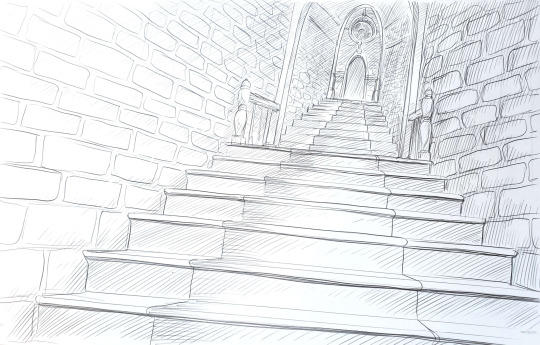
This seems fairly likely to be a Damsel Chapter 3 considering the instrumentation and design of the cabin, but this comes with another layer of thematic implications... In a Chapter 2 about archetypal ideas of the hero and damsel, what does it mean to have a Chapter 3 where the game's own musical and structural archetypes are subverted?
I really adore how Slay the Princess' OST supports the ideas and themes of the game through musical devices. The whole game has 3 leitmotifs (The Princess, The World-Ender, The Shifting Mound), but even just within their respective tracks, there's so many connections. For example, the bass arpeggios in the Princess become the melody of the World-Ender, and both motifs appear in the piano of the Shifting Mound. (This post by @tvlandofficiall goes into more detail)
With the way these themes meld into each other, are they even separate themes, or the same theme, just seen through another perspective?
Meanwhile, every other track in the game is built off of just these initial themes. Besides being a musical feat, it's also significant that no matter how far the story strays and the environment changes, it is always represented by the same themes, all of which represent the Princess in some form. Everything, apart from the silence of The Long Quiet and the fading murmurs of the Echo, is Her.
All this is to say that the music in this game absolutely says something about the characters and its story, and I think that this new track is no exception (and also that Brandon Boone does brilliant work and I respect the hell out of this entire dev team).
#og post#analysis#music#stp#slay the princess#the pristine cut#the damsel#slay the princess spoilers#the pristine cut spoilers#i completely understand why abby & tony don't want to reveal too much about tpc before release#especially relating to the chapter 3s#but man does every little tidbit of information get my brain going
12 notes
·
View notes
Note
can i get any commentary you have on seagull causing a storm :3 maybe something on the "are you ahead or behind me" bit of dialogue if you have anything to say. i always thought that part was interesting
hiii good morning 🧡 commentary to a fic as a whole? i guess i'm just going to rumble on about my vision for it, etc. ty for the ask🧡
in general I just wanted to muse around themes of fate, the butterfly effect and choice. the fic starts in the little scene at the end when they both choose each other at the same time, but it's a drunken subconscious decision, rather they collide. that event is a catalyst for a whole year of events that follow. the night left some heavy tension and reopened old wounds, as I imagined that it just didn't lead to anything good at the moment. bojan pulled back, kris got his hopes up and got hurt.
kris was clearly already in love for a long time and his arc is really all about these motifs around fate and small actions that lead us to each other. he sees that bojan doesn't love him at the same volume (or doesn't want to show it/accept it, whatever) he's just not there and he might never be. he is kinda refusing to think about being left/hurt/used by bojan's inability to reciprocate but is also acknowledging that his affection still runs on the background, it doesn't die despite the years or the hurt. he's more focused on the reasons to hold on to the love.
meanwhile bojan is on his own journey of personal growth, self-reflecting and finally self-accepting, all of it more rapidly since meeting jere and having that whole esc experience. I guess I should've made this part more clear and just expanded more on the topic, but at the time kris's attempt to start a new relationship as a remedy that ultimately failed resulting in just more pain piled on top of the other one seemed more interesting.
and I guess it's all about these mysterious ways we exist next to each other, and what some may call fate. kris & bojan & me by the end denounce fate because ultimately what leads them together and breaks the wall of tension, of things left unsaid, etc isn't fate, it's every choice they made along the way, big or small. it's kris picking up guitar and saying I want you no matter the cost, and then sticking to his choice for years no matter the hurt of seemingly unrequited love, it's bojan making the call despite the fear of what's to come, despite not knowing what to say or how to say it, despite knowing they might hurt each other again. I think it's much more rewarding to know that the other person chooses you over and over again and is willing to work and hurt for it than believing in fate.
regarding the line first time it came up as a text from bojan and when I typed it i was like hmmmm wait here a second mister wouldn't it be a bit fun to play with the wording of timezones and "depends on the topic" is for the readers to indicate that we are wrapping this line in double layer. and next time in the conversation bojan basically asks are you like me, just coming to fully realize what you mean to me and being okay with it or are you way ahead of me and already know? he’s so silly for that. just a guy. kris should’ve hung up on that mf not realizing he had this shit figured out for years. I knew those babes aren't gonna have a normal conversation in that scene anyway so why not have a little play with words just for our reading pleasure 💋
11 notes
·
View notes
Text
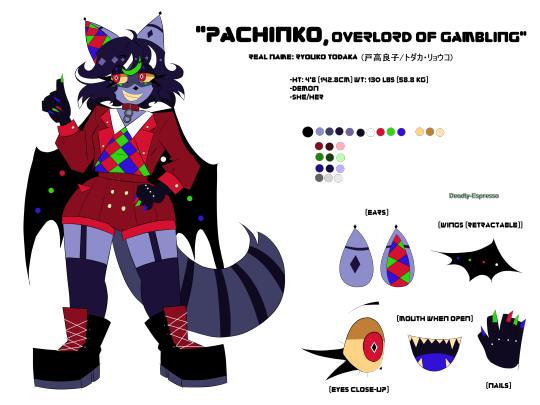
(OC: Pachinko)
DE made a hazbin hotel oc wtf!!!
(okay for some background stuff on this character, I originally conceptualized her wayyyy back in August of 2020 but never really did anything with her cuz i didn't actually have that much interest in Hazbin Hotel as I do now, and it didn't help that there wasn't that much lore to work with at that time. But now that the 1st season of the series proper has come out, we've gotten some more lore, and one bit of lore that interested me is that Husk (everyone's favorite cat bartender) used to be an Overlord (possibly of gambling???) but he had lost that status when Alastor took his soul??? So that got me an idea... what if a new Overlord stepped in to take Husk's place in the gambling scene following his absence?)
(also yes Pachinko is a Sinner demon and an Overlord, she was born in 1953 and died in 1987)
i'll probably reveal more about her later, but in the meanwhile you can have this:
- Pachinko's of Japanese descent and grew up in Japan, if her name and theming didn't give that away already
- if you're wondering what kind of animal she's supposed to resemble, well I gave her both motifs of a bat (it's a bit of a pun since Pachinko's a very opportunistic person, and the Japanese word for bat, Koumori (コウモリ), can also mean "opportunist") and a Japanese raccoon dog/tanuki (it came to mind because tanuki are known for being tricky and also they're associated with money and financial luck, which I think fits Pachinko well). Her beta designs originally only had bat motifs.
- Pachinko used to be close friends with Husk back in the days when Husk was an Overlord, but the two ended up having a falling out when Husk lost his status due to losing his soul to Alastor. Now the two are quite distant and have a lot of beef with each other.
- Pachinko is bisexual, and has a secret crush on the Overlord Velvette (also Pachinko and Velvette are friends, and Pachinko probably gets along with Velvette the best out of all of the known Overlords).
10 notes
·
View notes
Text
Assigning Milgram Characters Mili Songs
combining my favorite media for maximum serotonin! i hope other people do milgram song assignments because i will listen to your favorite song if you tell me it reminds you of my fav milgram character.
(IF ES WAS HERE THEY'D GET STRING THEOCRACY OR EXTENSION OF YOU!!!)
Haruka — Birthday Kid
"In my dreams, you praised me and clapped. Then mommy said, 'It's alright, there's always next time. You did your best""
I was so tempted to put in Ocean Bby instead so I could post the spotify cover of a guy in the mili mascot costume smoking but. unfortunately. Birthday Kid is clearly the better Haruka song. Themes of wishing for a family, coping with loneliness, and believing it's your fault you lost everything. #Harukacore
Yuno — Sideshow Duckling
"Golden Rouge. The duckling rubbed it and thought 'I'm enough to win my own approval'."
I'm not too sure about this one but the overall story struck me as Yuno? It's a bit hard to explain but the sweet yet insecure swan revealing a darker version of herself and learning to love herself felt similar to Yuno's Umbilical/Teardrop arc. I feel like there's probably a better song out there though.
Fuuta — Rightfully
"Lubricate our blades with blood and tears, and your piercing screams are music to celebrate."
I'm not too sure about this choice but I think it's passable? The fantasy chanting, the knight motifs, the dnd refetence, rallying with a group to defeat an enemy, it feels #Fuutacore. Alternately I'd consider Iron Flower but that's solely for the fire motifs.
Mu — Mitsubachi
"Everybody has two distinct faces Don’t you agree? Are you saying you’re special? Oh stop dreaming will you?"
Some of my choices barely fit meanwhile Mu recieves the bilingual french-japanese song called Honeybee. I don't think I need to explain this assignment any further.
Shidou — Bulbel
"I’m still my insufferable self. Setting my hair on fire, giving you warmth. Hoping you’d realize I want you by my side. May the lilies bloom for me."
Wow, Shidou gets the coffin flower song who could have foreseen this. I think the song's theme of going through several sacrifices in exchange for the happiness of someone you love fits him well enough.
Mahiru — From A Place Of Love
"There's just so much work, too much work to be done. Committing to commitments. Hiding my indulgence. The freedom we sacrifice for love."
Mili has a roster of sad romantic songs so this is a honestly a tie between this song, Turtle Heart, and Bathtub Mermaid. However, I settled From A Place Of Love becausw the song's progression from enjoying eachother's company to being thrusted into marriage too soon and then realizing you regret ever being in a relationship together struck me as #Mahirucore.
Kazui— And Then Is Heard No More
"Would you say that someone who had every intention to be brave was a coward?"
Kazui got the soft ballad song again! It's hard for me to describe it but I think this is a good pick for him? Feeling dispirited because of your inactions and thinking about how your life could've been with someone who's dead. It really resonates with me but I'm not confident enough with my knowledge regarding Kazui.
Amane — My Creator
"I wish you were here, I wish you were here.
You would have been so proud of my achievements."
I think Mortal With You is also a good Amane pick but I felt more inclined for My Creator. Sometimes it's obscure when Amane's talking about "Father" if she means her actual dad or her God. I think My Creator being about someone's abused experiment wanting the love of their Father/God/Creator fits her along with the religious motifs.
Mikoto — Camelia
"Nobody is born a fighter, there isn't enough space for all of us. You don't have to act so tough. No one can make you budge."
I hate this pick so much this is easily the worst but I couldn't find anything for Mikoto. I settled for Camelia because one of Mikoto's major themes is protecting himself, and Camelia is about an elder sister protecting her younger one by shooting a man. The reasoning is shoddy and if anyone can provide a better song I love you.
Kotoko — Paper Bouquet
"If the future needs a billion samples of flowers, I’m your reaper. I’ve no colour so the least I can do for you is endure."
Whereas Mikoto is protecting himself, Kotoko wants to protect others. There's lots of Mili songs where the narrator wants to do something for the sake of the one they love but in the end I settle on Paper Bouquet for Kotoko. I'm not too sure about but I think the chorus about "a means to an end," and having to bury a highschool student would be something that'd spur Kotoko into protecting those weaker than her. Does that make sense?
#milgram#i had to listen to so many mili songs back to back to back for this#pros: i found some new songs i like!#cons: oh my god my brain was fried afterwards#if you've never seen ocean bby this is your sign to go look it up on YouTube#꒰ 🌼 ꒱ ── cinnamon prattles
26 notes
·
View notes
Note
I'm curious. How would you compare Fire Punch to Fujimoto's other works? While I did start with CSM, I was just sort of meh about it? Meanwhile, I adored the short stories, especially Look Back.
oh man that's a complicated question. i imagine by the short stories you also mean goodbye eri rather than his earlier one-shots (correct me if i'm wrong).
so the thing with fujimoto is that while he's a pretty eclectic writer there are recurring ideas and motifs in all of his works, as well as a distinctive sense of humour and sense of absurdity and a certain.... mood. but in the recently released collection of early one-shots, he talks about how look back was basically him finally making peace with himself as a person and artist after a long period of depression and an unhealthy relationship with his own art. and i think it absolutely shows--his earlier works are experimental but there's def an undercurrent of misery and self loathing through several of them. and nowhere does that show more clearly than fire punch.
chainsaw man is..... it's a shounen, at its core, not simply a "deconstruction" of it because it DOES pay loving homage to some aspects of shounen, as well as action b-movies and superhero media. fire punch is not a shounen. it shares some core themes with chainsaw man, but.... it's a very messy work and it's far more explicit and brutal in its violence than chainsaw man is. i've seen some folk call it grimdark/edgy, and i think at times it can def feel eyeroll worthy, but i don't think fujimoto wrote that violence for the sake of being edgy or cool. it's very clear that fire punch is, at its core, about suicidality. it's also about struggling to find your own identity in relationship to others, about how you use storytelling both as a way to cope and survive and as a way to justify your own actions. chainsaw man gets very depressing at some points but it is ultimately more hopeful. fire punch is about a man who is constantly on fire and feels every second of that agony. it's about systemic dehumanization, both through oppression and hero worship.
its mood is very different from chainsaw man. its plot structure and influences are also very different. it's a lot darker and cruel and more cynical than chainsaw man ever is, nevermind later works like look back and goodbye eri. it's also intensely personal--the hardest parts for me to read don't involve rape, or mass murder, or burning alive. they are the moments where the main protagonist wants nothing more but to die, when the world is a black hole he cannot escape, when he is self harming and when the very act of existing causes him incredible mental and physical anguish. it's such a raw depiction of what being actively suicidal feels like, especially when you know you can't kill yourself despite feeling like you have nothing to live for. it's.... very, very personal and real. there's no doubt in my mind that part of why fire punch is such a messy story and why it's also so raw and bleak is because it reflects fujimoto's state of mind at the time, or at least something he'd experienced very recently.
so like, if that's something that feels like your thing more than chainsaw man (especially if what turned you off in csm was stuff like the silliness and b-movie references and the absurd hyperviolent comicbook feeling) then i'd rec it, with a lot of caveats/trigger warnings, because while it's incredibly flawed it's also really unique and interesting. i will say that i compare fire punch and chainsaw man a lot because i feel like the two inform one another. despite their different tones and inspirations, chainsaw man reprises a lot of motifs and ideas from fire punch, and for some of these fujimoto's intentions are to build on them and improve his previous takes on the matter. rn part 2 of chainsaw man focuses a lot on how people perceive chainsaw man the superhero, how that identity is built and defined by outside people and the accompanying hero worship and deification and hypercommodification of said identity. cannibalism as a form of self sacrifice and grotesque enmeshment is also a thing. so are movies as a way to find meaning and connection. if these are a turn-off and things you didn't particularly enjoy in chainsaw man, i think you'll be turned off by the messier and earlier takes on them that are found in fire punch.
what fire punch does have that chainsaw man doesn't is togata, who's canonically trans and The Character Of All Time. i'd rec fire punch only for him, though he unfortunately leaves the narrative by like halfway through the story (and it's commonly agreed that after his exit fire punch is a lot less coherent and kinda loses steam, though there are still some very powerful moments and ideas) AND again, there's no trigger warning that doesn't apply to fire punch lol. i love togata with all my heart though.
i will say personally that reading fire punch gave me much greater appreciation for chainsaw man and vice versa, as well as more appreciation for his later one-shots. fujimoto first worked on it when he was 22-23, and again it was clearly a very dark part of his life. so it's a bit of a mess, and often it reads less like a coherent story than as a very personal and raw attempt to put his worst emotions into his art. which to me is also valuable. if you're ok with say, the first 2-3 chapters, then def continue on and give it a try. you might not like it and feel frustrated by it, but at the very least it might give you more insight and appreciation for his later stuff!
12 notes
·
View notes
Note
I gotta ask for those Lila/Silver thoughts. I have some, but I want to know yours 👀
(Sorry, Anon, your ask took me longer than I anticipated!)
As you can see by now, we love Lilia and Silver a lot. We’ve posted some headcanons a couple of days ago, so in this reply I’ll just share my thoughts in general, if that’s okay. It ended up being a long post yet again…
You are also welcome to share your thoughts, Anon! Since it’s not too often that we get to hear about them as a ship.
We were initially intrigued by them and drawn to the ship because we really liked both Lilia and Silver, and both their character types and their dynamic felt really up our alley; but once we started learning more about them, we ended up becoming even more in love with Lilia/Silver both separately and as a ship.
If you’ve read our OruIde post, you might remember that we really love ships in which characters influence each other in a significant way, and have qualities that bounce of each other nicely, contrast each other and kind of clash against each other. We also love the ships that has a motif/theme in the center of it, and with Lilia and Silver, it is a theme of emotional connection and attachment.
I really love that Lilia, despite his friendliness and open-mindness, is still kiiiiiind of emotionally detached from even the people we would consider being his closest, at least to a certain degree. He cares about them a lot, he feels protective over them and I’m sure he still feels responsible for them, but the scale of these relationships is way more different to him than to the boys, at least Sebek and Silver, since they are super young compared to him.
Focusing on Silver; you cannot compare feelings a 600-year-old being has for someone he only met like 17 years ago, and feelings of the said 17-year-old has for someone who’s been the most important person to him for his entire life. Because of that, even though Lilia logically understands that human beings perceive things differently than him, he still can’t really grasp just how important he is to Silver and how much Silver truly loves him.
Silver, even though he is dear to Lilia, is a tiny fragment of his rich and long life; and to Silver, Lilia is pretty much his entire life. Once again, it’s not because Lilia just wants to distance himself or doesn’t like Silver, it’s entirely because of how different their perception of life/time and their approach to it is.
In contrast to Lilia, who is super friendly but a bit lacking in understanding his own impact on others’ lives, Silver seems aloof and strict, but he is in fact very sensitive, very gentle and reflects on his feelings and interaction with others quite a lot. This is like the exact opposite of Lilia. Gooood I love contrasts.
And just like with OruIde, all of the stuff that’s I’ve just talked about works nice platonically, but since we’re out there shipping, let me just stress how freaking romantic this whole deal is. When it comes to our favourite shipping tropes, Silver plays the role of a super loyal, selfless and desperately attached guy perfectly, and, in contrast to Malleus (yay more contrast), he doesn’t feel entitled to Lilia’s absolute attention, so he just loves him silently and doesn’t allow himself to be selfish about it.
Lilia/Silver is also quite a nice ship if you like darker scenarios and psychologically messed up themes, because let’s be honest, whatever they have going on, it’s never going to be healthy, and not because Silver calls Lilia father lol These two could never be equals. Lilia is always going to be just a little bit patronizing, just a little bit detached, just a little bit neglectful of Silver’s feelings, simply because he doesn’t have a grasp of just how much he means to him. He also probably thinks that Silver has his entire life ahead of him (which is correct) and that it wouldn’t really matter to Silver if he stays by his side or not (which is super wrong). Meanwhile, Silver is out there having an existential crisis at a Halloween party because it just dawned on him that Lilia might leave him/die someday and it is definitely going to be a sudden parting.
This isn’t every single thing I have to say about these two, of course, but I’ll just end up going on about “hey remember how Lilia wanted Silver to experience trick-or-treating”, “hey remember how Silver was looking for a souvenir for Lilia at the City of Flowers”, “hey remember-“ for five more pages… Let’s just say that whenever these two interact or talk about each other and their time together, it’s always the best thing.
On a lighter and spicier note (haha let’s talk smut), god these two have a lot of potential for that, with Silver learning stuff from Lilia and really wanting to please him, Lilia playing around with Silver and overdoing it greatly because that’s how he’s always treated him in a lot of other aspects of his life; this whole thing either being a hot secret or a (potentially shameful??) thing that everyone is aware of but can say nothing about. I am honestly shocked that there isn’t more fan-drawn stuff for these two.
Oh, and also! This face. Of course Silver does it in some other situations, but he really tends to give this soft smile to us whenever he is talking either to Lilia or about Lilia. This is his “oyaji-dono” smile, I love how gentle and cute he looks there. Aww.

17 notes
·
View notes
Note
Would you do 2, 9, 12, and 18 from the AU ask game, please?
Uh-oh! You didn't specify an AU! I'm just going to pick The Other Side of the Coin because no one has asked about it yet, but if you want answers for one of the other ones, please feel free to send me another ask!
Summarize this AU in 5 sentences.
This is a collection of oneshots in an FMA genderbender AU. Ed and Al are girls, Winry is a boy. Elaine Elric and her younger sister Adelaide are on a quest to find the Philosopher's Stone and get their bodies back after failing to bring their mother back through human transmutation. Meanwhile, Winston Rockbell waits for them and fixes El's automail every time she breaks it again. The plot mostly plays out the same, just with different nuances because the protagonists are girls.
9. Is there a scene you wish you could've included, but couldn't? Why?
Part of me kind of wants to explore further what it would be like for a twelve-year-old girl to join the military. Specifically, I've had some vague thoughts about El being harassed by some men in the showers early on, and Mustang comes to her rescue. His response is enough to scare off any further attempts at harassment, and he makes sure that after that, Addie always accompanies El to the public showers. (Because there's nothing like having a giant suit of armor guarding the door to discourage pervs!)
So like...part of me thinks that's a really interesting thing to explore, an experience that would definitely be different for a girl. But it's also a really icky subject, and every time I seriously sit down to plan it out, I just end up noping out of there :/ I think I may have to just sort of mention it in passing in one chapter or another, as something that happened in the past, without going into much detail.
12. What's your favorite line from this fic?
“Hello!” El griped loudly. “I'm only bleeding out of every orifice here!”
18. Is there any theme or motif in this AU that isn't in the original work?
Strictly speaking, Parental!RoyEd doesn't have a super strong presence in the canon. It's generally more-or-less compatible with canon (depending on how in-character the writer keeps the characters), but there aren't just a ton of scenes of Mustang being overtly fatherly with the Elric brothers. And yet, I'm a total sucker for it. It's in my top three favorite FMA relationships (I go back and forth on whether I like it or Royai more :P).
So of course, once I started writing this genderbender, I knew Parental!RoyEl was going to be a big part of it. And even if you argue that Parental!RoyEd is canon, the relationship takes on a subtly different tone when it's a father-daughter relationship. I absolutely adore father-daughter duos, because there's a certain gentleness that creeps into their interactions, even with someone as volatile as El who would be the first to tell you (at the top of her lungs) that she doesn't need a father. But you do, El. You do :')
AU Asks
#ask and you shall receive#anon asks#ask games#full metal alchemist#fullmetal alchemist#fma#genderbender#edward elric#elaine elric#alphonse elric#adelaide elric#roy mustang#winry rockbell#winston rockbell
4 notes
·
View notes
Text
my ocs' masquerade outfits!

listen. the shading and coloring might be a bit messy here and also i didn't really try to make their outfits "historically accurate" or anything like that, i just went with anything that looked pretty or elegant enough, haha.
also i spent six hours working on this. i think it's okay for me to be lazy with shading and coloring because of how tired i was
so, for this event i chose seth (because he's my mc, so of course he's coming), merrill (because he was the only nrc oc that came to my mind when i heard about this event. i just think it would fit him), hayden (yes i know i've been giving him way too much attention lately, but. i had to make him interact with rollo, come on, HE IS GONNA MEET SOMEONE FROM THE OTHER SEVEN), allen (i just wanted him to wear an outfit like this), roland and fake!jay (again i just thought that this event is perfect for them)!
I HAVE A REASON TO ADD RSA OCS TOO, OKAY. it was mentioned that other schools are also participating, so i'll take it as a sign that rsa students are there too <3
now, some design notes because I PUT A LOT OF THOUGHT INTO THESE OUTFITS.
seth's outfit is supposed to be similar to grim's because it was mentioned in the event that their outfits look almost the same. but grim insists that he still looks better
seth's mask is dark purple and it (+his cape) has sun motifs as a reference to the flag of corona, rapunzel's kingdom. it also has "a drop of sunlight" in the center, but it's not that noticeable.
IT'S A JOKE FROM THE SERVER, but i decided to make it canon: seth's shoulders are actually open here, but when rollo saw it, he got a bit nervous and he gave seth a cape, so that he can cover them. seth didn't like that, but he agreed to wear it, because his mind went "okay, this guy looks kinda scary, i probably shouldn't get on his bad side".
merrill's outfit is mostly purple with some pink details, as a reference to the colors of meg's outfit. he also wears a hat this time too because i miss estelle (and her mom too, of course) 😔
ANOTHER JOKE FROM THE SERVER, at first merrill showed up in a more revealing outfit and he liked it a lot, but rollo said that "it must've been the wrong version", apologized and asked his assistants to bring the right one. merrill wasn't happy about it and he even wondered why would they make an outfit like that in the first place. he also didn't like that he has to wear something completely different, meanwhile seth still gets to wear his outfit, he just had to cover his shoulders.
hayden's outfit is supposed to be a MUCH MORE simple version of azul's outfit (or octavinelle one in general), not only because i was lazy to draw ALL THE DETAILS, but also because a version like that fits him more in a way. hayden doesn't want to draw too much attention to himself or at least that's what he says
his mask is supposed to look like a chameleon and his belt is supposed to look like it has eyes on it. i originally planned to draw more eyes on it biblical angel-core and all, but i changed my mind.
allen's mask has the same colors as one of anna's dresses from the first movie and his outfit has a lot of hearts on it as a reference to his romantic nature. it also has pink and blue colors, like the sweater he usually wears.
YES, ROLAND EYE REVEAL. at first i thought that maybe he didn't get an eyepatch at all could be a subtle reference to rollo possibly hating fairies but what if he actually could choose between a mask and an eyepatch and he still chose a mask because he wanted to look like he's actually going to a masquerade? he would say that his eyepatch wouldn't fit for this event and he doesn't want to stand out much. he also would apologize to everyone if they think that his "other eye" looks scary.
I THINK YOU CAN REALLY SEE THAT I GOT LAZY WHEN IT CAME TO ROLAND'S OUTFIT JDKESDLSLSDL. it has this nature theme, because of course it does, he's the gardening club leader! so yeah, there's a lot of flowers, tree branches and leaves, if you look closer.
i wanted jay's mask to look like it has vines on it and i'm not sure if i succeeded dnjdkdkd. i also thought that maybe he could have this "young detective" vibe? i don't know why i thought about that, but it seemed like a cool idea to me.
so i thought that if nrc outfits are mostly black (or have dark colors), then rsa outfits should be mostly white, but jay doesn't really wear anything white here (except some details). it's like a reference to him being different from other students and him not being "real".
#yes seth and merrill's outfits look almost the same dhdjsdkesd they be twinning <3#and yes merrill and allen's outfits are kinda similar to the ones they wore in ghost marriage. i am not that creative#we do not talk about how short one of roland's arms is#hehe. roland and rollo. two rolling boys#lina draws ocs#the isolated prince: seth#idia's e boy servant: merrill#the chameleon with a god complex: hayden#the ultimate simp: allen#the gardening club leader: roland thorn#the literature and animals lover: jay
4 notes
·
View notes
Text
Well, it’s not quite a master’s thesis, but this is (the first of) a series of posts on why Catra and Adora are the best love story in the history of kids TV animation and maybe the greatest love story in the history of TV. This may in some ways be faint praise - romance on TV is generally not very good compared with books or movies. Often it’s just some will they/won’t they sexual tension that is defused by getting characters together and re-heightened by breaking them up. TV is full of nearly shark jumping pointless dramas like Sam and Diane (Cheers, holy fuck am I dating myself, though that was technically before my time), Ross and Rachel (Friends, which was no Cheers) etc, but also some less annoying couples like Ben and Leslie (Parks and Rec) or Amy and Jake (Bk99) who are mostly just kind of cute and fun. Other shows, like the X-Files, teased viewers for years with unresolved sexual tension. In kids shows most romances are, appropriate for their target viewers, mild, sweet relationships based more on self-conscious flirting and blushing than on complex and conflicted feelings or deep passions - which is pretty realistic when the characters are young teens or even mid-teens. Some of these relationships are really well done - Finn and Flame Princess, Dipper and Pacifica (yeah I ship them), the early stages of Katara and Aang (before the showrunners imbued this childhood crush with cosmic significance), Steven and Connie, etc. Catra and Adora, though, are different. Their love story is not a side plot or a sub plot, it’s the heart of the show. It isn’t a childhood crush, it’s a very messy and passionate relationship between two young adults. She-Ra is an emotionally complex lesbian romance just as much as it is a thrilling action/adventure show. Everything about their relationship is baked into the show’s plot, its themes, hell even its musical score. The dramatic tension between Catra and Adora is not the result of stretching out a flirtation for ratings, but a coherent dramatic arc that runs through the entire show. As Noelle said, he made Catradora so central that execs couldn’t take it out without ruining the show. And the show is better for it. In this series of posts I’m going to try to show why, as well as showing why She-Ra is such a fantastic love story.
First off, let’s talk about how Catra and Adora’s character arcs are foils for each other, and how they come together and apart through the series. This is actually a post that I’ve been working on for a while but I keep summarizing the show rather than cutting to the chase, so I’m not going to recite many plot points so much as sketch out what’s going on with the dramatic structure at the time. But also, let’s talk about what each character’s arc is saying, and how they are commenting on each other. Spoiler alert: Catra’s arc is a subversion and critique of stories of empowerment through ruthless self-assertion and revenge, while Adora’s arc is a subversion and critique of chosen one narratives and stories of self-denial and self-transcendence.
When the show starts, Adora and Catra are shown as rivals and friends - their first scene starts the recurring motif of them reaching out for each other as one of them dangles above an abyss, as well as establishing their flirtatious banter and easy camaraderie. We quickly learn that these two young women plan to conquer the world together. These scenes and later flashbacks show Catra and Adora as deeply enmeshed in each others lives, to the point where neither of them (but especially Catra) have clear identities outside of one another. There is so much genuine love on both sides before Adora leaves, but also resentment, envy and fear, especially on Catra’s side, as well as a protectiveness on Adora’s side that deprives Catra of her autonomy. They are both being abused by Shadow Weaver - Catra physically and emotionally, Adora emotionally. It wouldn’t be too much to say that Shadow Weaver holds Catra hostage to control Adora (this is why critiques that Adora abandoned Catra to be abused are actually kind of messed up, since they accept Shadow Weaver’s premise that Adora is responsible for what Shadow Weaver does to Catra). In addition, Catra and Adora actually see the world incredibly differently. Adora already sees the world in terms of right, wrong and her destiny to right wrongs - this is why it’s important for her to accept the Horde’s obvious lies - she couldn’t keep living if she didn’t. Catra, on the other hand, sees the world solely in terms of survival and personal loyalty - everything for her is about preserving herself and the person she cares about - Adora.
Then, when Adora finds the sword, she leaves because it’s the right thing to do. Catra doesn’t even have a concept of ‘the right thing to do’ being something she should care about, or perhaps, something she can care about as an irredeemably evil, awful fuck-up. So at Thaymor neither one understands where the other is coming from, and Catra and Adora begin to part. This is the first turning point in their relationship. Adora chooses duty over what she desires, Catra chooses to protect herself (such as she sees it) and nurse her sense of betrayal and abandonment.
Their relationship until Promise is a kind of weird Frenemy thing that is fascinating to watch and sold me on the show. Neither one wants to fully admit to themselves that the other is now their enemy, neither one has given up on changing the other’s mind. Each is furious at the other, and desperate to see her again at the same time. There’s a lot of heartache and just as much sexual tension, especially at Princess Prom. Both of them come alive when they fight each other (more about that in a later post). But they’re already growing apart - Adora embracing her destiny as She-Ra, Catra rising in the ranks for the Horde. Adora now has the purpose she always wanted, plus other friends and a sense of being chosen to do something great, while Catra now has power - the means to protect herself from people like Shadow Weaver as well as the vindication she had always been denied, and even the opportunity to beat Shadow Weaver at her own game.
The next turning point is Promise. Holy fuck, this episode. It’s an episode that is even more heartbreaking after you’ve watched the show because you know just how much worse things are going to get, and yet, it’s a necessary part of both of their character arcs. Even through season 1 Catra and Adora had remained very much enmeshed in each others lives in an increasingly fucked up way as they grew apart but refused to turn away from each other. Even though they aren’t -exactly- a romantic couple (Adora doesn’t recognize and acknowledge her feelings until the last episode of Season 5), Season 1 of She-Ra is one of the worst breakups I have seen on TV. As I said in a couple of previous posts, this is the kind of shit that the Mountain Goats write songs about. Everything that was poisoning their love for each other even before episode 1 bubbles to the surface and combines with them fighting on opposite sides of the war to make a truly fucked up situation. In the end, it’s Catra that makes the choice to turn away from Adora. This isn’t a -good- decision. It’s spiteful, and destructive, and based on an outright deluded understanding of their relationship (inspired by Light Hope’s manipulations and her own issues), but it’s in some ways a necessary decision. Catra has been so wrapped up in Adora for so long that she isn’t going to be able to figure out who -she- is without cutting Adora out of her life. And the same is true of Adora.
But each of them do this in about the worst way possible. Catra embraces destruction, ambition, manipulation and outright cruelty, turning the tactics of her abusers against them and against everyone around her. She first triumphs over Shadow Weaver and manipulates Entrapta into trying to corrupt Etheria itself. Meanwhile Adora ‘lets go’ and commits herself to the self-denying mantle of She-Ra. Over the next several seasons, their respective paths will nearly lead both Catra and Adora to their deaths (in the Season 4 finale).
For the next season (counting season 2 and 3 as one) Catra and Adora are still closely linked, but as enemies. Still, there’s more than enough flirtation between them (that ‘Hey Catra’ in the first episode of Season 2 is something else), and especially on Adora’s side we see her hold back with Catra, and often take responsibility for the harm Catra inflicts, just like she had when they were kids. Yet they still drift apart - after facing off every other episode in Season 1, they spend less and less time on screen together through season 2 and 3. Catra continues her ascent to power and descent into villainy while Adora becomes more of a stressed out mess as she takes the fate of the world and the wellbeing of everyone she cares about on her admittedly broad shoulders. Catra’s one moment of vulnerability is rewarded by Shadow Weaver’s betrayal and her exile, then Catra triumphs in ruthless badass fashion through sheer desperation and aggression. In the Crimson Wastes, we see Catra at her most independent, and she almost seems happy. But once Adora shows up and Catra hears about Shadow Weaver, she’s sucked back into the worst of her resentments, and she makes very clear that being happy is less important to her than making sure Adora is miserable.
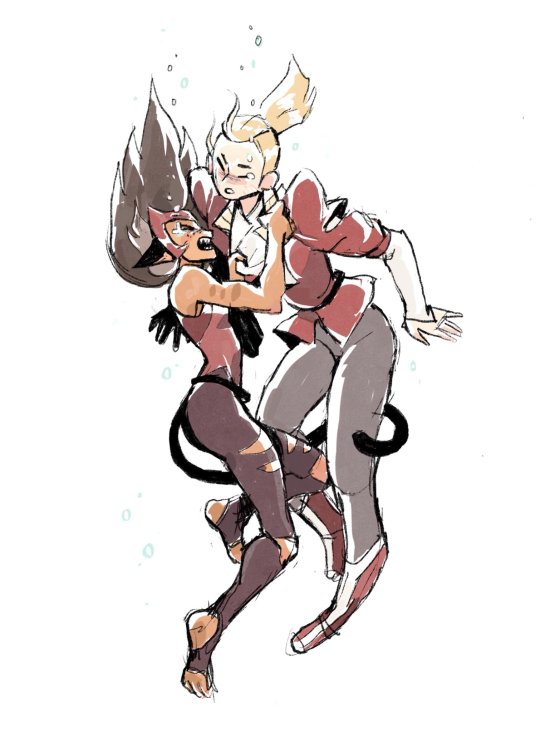
This changes everything. Catra completely breaks with reality and tries to kill Adora, herself and the world rather than lose to Adora and Shadow Weaver (I do think it’s important to remember that she does that after Shadow Weaver nearly kills her). Catra betrays everyone around her when she exiles Entrapta, threatens Scopria and lies to Hordak. Then she flips the switch. When Adora tries to fix things, Catra fights to her own death to make sure that the world disintegrates with her. For her part, Adora fights first to understand what is wrong with the world and then to fix it. Finally she tells Catra that destroying the world is her choice and she has to live with it, decks her, and then sees her off with a death glare once the portal is closed. With this, Adora writes Catra off even if, as she says later, she never never hated her. By doing that, Adora casts off the guilt that had dogged her and takes responsibility for her own life rather than someone else’s - this is actually a huge step for her, and one that will become more important in Season 4.
Season 4 is in many ways the nadir of their relationship. They only see each other once during the entire season, in Fluterrina, when Adora tries to blast Catra, much to the latter’s shock. There’s a sense in that scene that Catra is trying to have the same flirtatious enmity she used to have with Adora, and Adora is having none of it. Catra almost seems hurt by this, which is an early hint at how isolated Catra is beginning to feel. Catra spends the rest of the season at her highest and lowest. On the one hand she spends most of 12 episodes winning by every standard she has ever claimed to care about, besting Hordak himself in single combat and making herself co-ruler of the Horde and coming within a day’s march of ending the Rebellion. In many ways it is the ultimate empowerment fantasy - the abused young woman has defeated her abusers, showed up everyone who doubted her and forced everyone to respect her. But I think it’s striking that the show starts with her and Adora dreaming of conquering the world together and in Season 4 Catra nearly succeeds in conquering it alone, almost like she was trying to live out her old shared fantasy while proving she didn’t need her former best friend.
At the same time, Catra is clearly miserable. She’s always been unhappy, but in Season 4 we see her completely isolated and lying to herself and everyone who will listen in a desperate attempt to justify her actions. Turning the tactics of Hordak and Shadow Weaver against them to gain power and then against Scorpia and Entrapta to maintain it haven’t vindicated Catra, they’ve made her more and more alone as Entrapta is exiled and Scorpia drifts away. Meanwhile Catra reaches out to Double Trouble, and her interactions with them reek of a kind of desperate desire to have someone in her life (the feeling of their interaction is of an unhealthy casual relationship where one partner becomes emotionally invested and the other takes advantage of that while denying the other the closeness they desire). As people leave her, one after the other, it becomes clearer and clearer that Catra doesn’t want power at all - she wants connection, friendship, love, and power is a very poor replacement. As I said in my long Catra rant, Season 4 is both her ‘Walter White as a Catgirl’ season and the beginning of her redemption. Everything comes to head when Sparkles destroys everything Catra has tried to achieve, Double Trouble delivers those harsh truths and Horde Prime shows up and makes it all irrelevant, just highlighting how futile all her struggles and sacrifices and crimes have been.
Meanwhile Adora spends Season 4 becoming her own her and her own woman. After telling off Catra, she grows more and more disillusioned with Light Hope and critical of Glimmer (though the latter has more than a shade of her old habit of taking responsibility for others - Adora’s development is not linear). She’s gained the courage and confidence to strike out her own path, not just follow a destiny. At the season’s end she once again breaks with her best friend to do what is right, and discards the destiny that she was being prepared for. But in this case she isn’t chasing one packaged destiny for another, instead she’s making her own choice and literally shattering the thing that she thought gave her life purpose. It’s badass, and heartbreaking, and along with decking Catra and jumping after Catra into the abyss (see below) it’s the perfect Adora moment.
In many ways Season 5 starts with Catra and Adora farther apart than they have ever been. They aren’t even enemies anymore, they’re completely out of each other’s lives. And both Catra and Adora are lost at the beginning of Season 5 - Catra is useless and alone on Prime’s ship, completely defeated despite ostensibly being on the winning side, and she goes through the motions of her normal plotting without any particular conviction and none of her normal flair. Meanwhile Adora is even more miserable and self-destructive than usual, throwing herself at Horde Bots and working herself until she drops of exhaustion. In a very real way they both stay lost until they have a chance to help the other. Catra takes responsibility for what she’s done and what she can do, saves Glimmer (at least partly for Adora’s sake), apologizes to Adora, and sacrifices herself. Adora only seems to come alive when she decides to turn around, face Prime, and save the cat. And when she does, Catra and Adora’s arcs, which had separated so completely in season 4, come crashing back together to end the series.
Adora during Save the Cat is such a contrast with the uncertain, hesitant and self-destructive wreck we’ve seen so far in Season 5. This is possibly her craziest plan in 3 years of mostly cazy plans, but she never wavers or questions herself. Even when Chipped Catra appears and we see Adora’s heart break while we watch, Adora doesn’t back down or relent. She keeps at it even as the tears stream down her face. She fights better trying to save Catra without She-Ra’s powers than she fought at the Battle of Bright Moon with them. Catra’s just about as desperate - we see her cry and plead, and now is probably as good a time to any to point out how amazing a job both VAs did throughout the show, but especially in this episode, and how good a job the board artists did.
Seeing each other for the first time in a year, and only the second time since Catra blew everything up, Catra and Adora are probably the rawest and least restrained we’ve ever seen them. There’s barely any banter, no bravado, and no pretense that they are anything other than two women who desperately need each other (Prime doesn’t help with ‘You broke my heart’.) Then Catra is flung to her death, Adora jumps after her, breaks both her legs in the fall (we see her crawl to Catra, as though she couldn’t walk) and becomes the real She-Ra. It’s such a triumphant and deeply queer moment seeing a woman transformed into a warrior goddess to protect the woman she loves, and it’s the reason that, as dark as it is, Save the Cat is my Comfort Food episode.

Let’s not sleep on Taking Control, though. This episode is like a microcosm of what this show does best, especially the A plot with Catra and Adora. Catra’s reversion to lashing out at everyone and her refusal to be open to Adora shows just how much of a struggle this whole ‘being good and trying to connect to people’ thing is. Catra’s outburst gives Adora a chance to stand up for herself and refuse to be Catra’s punching bag, while also not trying to control her. Adora’s ultimatum gives Catra a chance to reach out to Adora (quite literally), and allow herself to be vulnerable. In this episode, we see just how far Catra and Adora have come since the messed up stew of their relationship in Season 1. Adora lets Catra be responsible for her own actions; Catra lets herself be vulnerable to Adora and takes responsibility for her actions. They’re both better people and better friends and better partners than they were, and the show has shown this in a strikingly nuanced and realistic way.
The important thing to note in the next few episodes of Season 5 isn’t just how much closer Catra and Adora get to each other and how much they flirt (So much. So much, y’all) but just how -happy- they are. We see both of them transformed in the other’s presence. Basically, since they’ve parted, both Catra and Adora have been defined in no small part by how miserable they often are. They have both had their triumphs and their lighter moments, but there’s been a sense of melancholy dogging both Catra and Adora since episode 1. And now that they’re together again, that lifts, somewhat. Catra’s verbal barbs have lost their venom, and she can openly show how much she cares for Adora and even Bow and Glimmer. She’s still herself - snarky, cynical, somewhat devious - but she’s not engaged in a self-destructive zero-sum struggle with everyone around her. Meanwhile Adora has spent 4 seasons being a neurotic and sometimes nearly joyless mess who takes responsibility for everything and often doesn’t let herself enjoy anything other than the odd BFS group hug (exceptions include trying to uh...impress Huntara and reveling with the butterfly ladies of Elberron in Flutterina). Around Catra, though, she’s a cocky, swaggering jock who gives as good as she gets. It’s a side of Adora we’ve only seen hints of before, and one that’s so much more confident and joyful even as the world is ending around her. Apart, Catra had tried to protect and vindicate herself with power and conquest, while Adora had tried to forget herself in duty and sacrifice. Together, they can be themselves again. This dynamic is crucial to the show’s portrayal of Catra and Adora’s romance because it doesn’t just show how much they love each other, but how they’re -good- for each other now that they’ve grown as people, and that they are so much better than they were when they were apart.
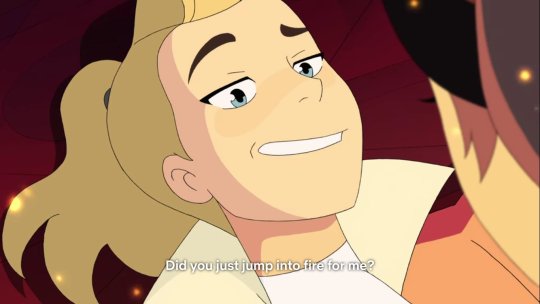
Until Shadow Weaver shows up. Their old abuser reintroduces tensions but even then things are different than they were. Now Catra isn’t just resentful of how Shadow Weaver prefers Adora - she’s protective of Adora, which is clearest in Failsafe when she calls Shadow Weaver out for being willing to sacrifice Adora. And while Adora takes the Failsafe, it isn’t to follow her destiny or because she has a death wish - it’s because she loves her friends, and she is the only one who has any hope of doing this and living (though Catra’s suggestion that Shadow Weaver take it is a good one). And finally, when Catra leaves Adora, it isn’t because she hates Adora, nor, despite what she says, is it because she really thinks that Adora chose Shadow Weaver. At least, not exactly. It’s because Catra loves Adora, and can admit that to herself, and can’t stay around and watch the woman she loves sacrifice herself rather than choosing Catra. Before Catra leaves, she asks Adora ‘What do you want?” It’s a question that echoes Shadow Weaver’s speech in Episode 1: ‘isn’t this what you always wanted since you could want anything?’ As much as Adora has grown as a person, and defined herself and stood up for what she thinks is right, she still has never answered that question - it’s never been ‘what do I want’ but ‘what do I have to do?’ and that’s how Adora answers Catra’s question. This is Adora’s last gasp as a self-transcending hero, letting go of what she wants (not that she ever dared articulate what that was) in order to do what must be done. And it nearly kills her and dooms the universe, because Adora can’t be the hero that she needs to be by being anyone less than herself.
But it’s losing Catra that inspires Adora to tell off Shadow Weaver for good (not that she’d ever really warmed to her after season 1). And it’s love for Adora that inspires Catra to stand up to Shadow Weaver and demand that she do the right thing. In both cases, Catra and Adora aren’t just standing up to their abuser, but holding her to account for the harm she’s caused, and it’s the love that they have for each other that inspires them to do this. In Catra’s case in particular her refusal to let Shadow Weaver weasel out of finding Adora is a much greater triumph over Shadow Weaver than beating her up and breaking her mask in Season 1 - it’s proof not so much to Shadow Weaver but to Catra herself that Catra really is better than this and that she deserves better than this. It’s not turning her abuser’s tactics against her, but truly holding her to a moral standard and demanding that she do the right thing.
And then there’s Catra and Adora together at the heart. Catra has already come back for Adora and stayed to the end, choosing to die with her even if she can’t share a life together (not out of some death wish, but because Adora needs her). And Adora, who’s been avoiding answering the question for three fucking years, finally let’s herself want Catra when Catra finally confesses her love (breaking the last of her self-protective shields) and asks Adora to stay -for her-. And by admitting what she wants, Adora can truly be at peace with herself and be the hero she needs to be, lesbianism saves the universe, The End.
So anyway, that’s how Catra and Adora’s stories are woven together and how they compliment and comment on each other. Narrativiely, Adora and Catra start together, come apart, find something of themselves, and truly find themselves and each other when they are reunited. Thematically, they are critiquing seemingly opposing narrative tropes - empowerment narratives and narratives of self sacrifice. But by showing the flaws in both types of story and showing how neither self-seeking empowerment nor self-negating self sacrifice can actually make us happy, She-Ra asks and answers more profound questions than most prestige dramas for adults do. I’ll get into how the show sells the idea that the power of love can bring us happiness (and save the world) in a future post. But next up, I’m going to celebrate just how much Catra and Adora’s relationship revels in ambiguity, complexity and contradiction and so tells a grown up love story in a kid’s show.
#she ra#she ra spoilers#she ra adora#spop#catradora#she ra netflix#she ra and the princesses of power#goat ship#long#meta
564 notes
·
View notes
Text
An Attempted Utopia
The city of Shumen in Bulgaria is home to the country’s largest monument to the Founders of the Bulgarian State. An enormous, cathedral-like complex on the plateau above Shumen tells the story of the early Bulgarian rulers through a series of larger-than-life modernist sculptures.
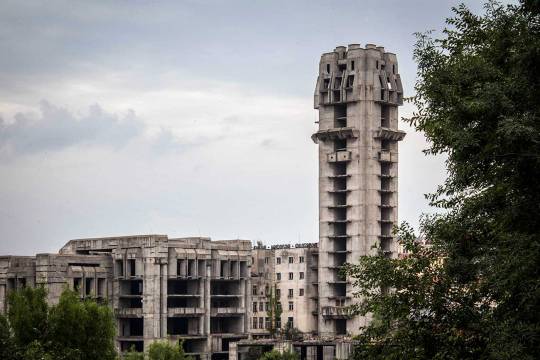
Shumen Central City Square (1988-1989), unfinished. Created by Ivan Sivrev, Elena Konyarska, Maya Petrova, and Tsvetan Vasilev; chief consultant architect Georgi Stoilov. | Photo © Darmon Richter
But while many other memorials built during the communist period have been doomed now to decay and obsolescence owing to their political symbolism – branded as they often are with hammers, sickles and stars – the Shumen monument, by focussing purely on the ancient past, has managed to remain relevant to, and loved by, its inheritors. Today this symbol of Bulgarian nationhood is better preserved than probably any other monument built during the 45 years of Bulgarian communism so many foreign visitors come to Shumen to marvel at it.
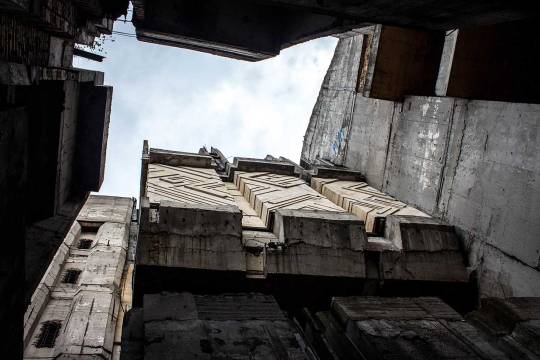
An upwards view, from deep within the abandoned construction site of the Central City Square concrete tower. | Photo © Darmon Richter
A vast concrete tower looms over Shumen’s city centre: phallic, foreboding, and visible from all ends of the city. Standing 18 storeys high, the tower rises from a construction site six storeys tall and spreading out to fill an entire city block. The Central City Square, a gargantuan experiment in urban design was intended to be revolutionary, incorporating shops, hotel, post office, cafes, restaurants, hall for weddings and rituals as well as municipal administrative offices but has never been finished.

Glimpsing the full scale of vast Central City Square. | Photo © Darmon Richter
When the Bulgarian Communist Party relinquished its single-party system at the end of 1989 the country slid into a chaotic and economically unstable democracy and many former state projects has been left incomplete. All over Bulgaria are the shells of abandoned construction projects, orphans of a dissolved government but nowhere any come close to the size of Shumen’s Central City Square. The tower, its most visible element, stood between two unfinished blocks which rise behind a security fence established right along the city’s central pedestrian area on Liberation Square. Only by peering over that fence, does one realise that the tower and both blocks are all the same building, joined through lower levels, dug into the hillside, with road access to the site from a street behind. The lower levels of Central City Square extend beneath the street, emerging behind you as tunnel entrances that look like metro stations. Hotel Madara, overlooking the square, was supposed to be connected with underground tunnels that would grant guests easy access to the complex.

Cross sections of Shumen Central City Square. | Drawing via Promisljena estetika (1988) Vol. 1
The street was redeveloped in tangent with the Central City Square project, around the pedestrianised area are motifs thematically connecting it to both the new complex and the monument on the hill above. For instance, the tallest column of the Monument to the Founders of the Bulgarian State is topped with a stylised black granite lion, based on a 7th century carving, a design that is echoed in the streets below, with sculpted bronze lion heads set like sentries along a sheer concrete wall. Opposite the lions, the outer wall of the new complex nods to a culture that predates even the first Bulgarians, Hermes the messenger appears in sculpted relief on the face of what would have been the new post office.

A modernist relief at the subterranean entrance. | Photo © Darmon Richter
This redesign of Shumen city centre was a world apart from the monumental design of previous decades. Nearby, the 1949 Monument to the Red Army on Slavyanski Boulevard was pure, unadulterated socialist-realism; even the 1965 Monument to Freedom leant heavily into safe political territory with its hero figure and engraved hammer-and-sickle motif.
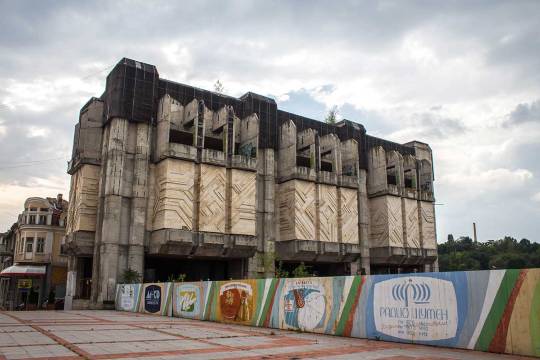
Western block rises behind an advertising fence.| Photo © Darmon Richter
However, the complex at the heart of this city project was bolder still. Intended to revolutionise Shumen’s urban landscape in ways that would have made this city notable not just by Bulgarian standards, but potentially one of the more advanced urban centres anywhere in the socialist world.
In an interview with Ivan Sivrev appeared in Industrial Aesthetics, Decorative Arts (1988), a monthly magazine published by the Bulgarian State Committee for Science and Technical Progress, the architect described the project as a forum for this 100,000-person city. “Central City Square has been designed as a living organism,” said Sivrev, “the elements of which are interconnected and interdependent just like, figuratively speaking, the organs of a living creature. We intend for Shumen’s centre to materialise as a synthesis between aesthetic, artistic, social, engineering, ecological and other requirements, instilling the rich historical past of Bulgaria into a modern development.”
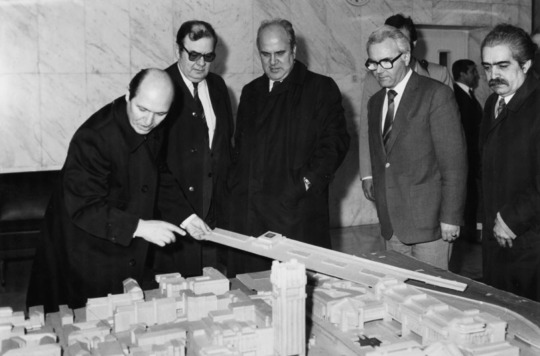
Ivan Sivrev (right) stands beside a model of Central City Square in 1988.
Sivrev lists the various facilities to be included in the complex “the ‘Man’s Industry’ Fashion House, ‘Pancho Vladigerov’ Festival Complex, the existing Hotel Madara, and on the first underground level, the House of Rituals and Services.” The Festival Complex alone was to feature “concert halls, a club house, recital halls, music rooms, a record shop and musical instrument outlets”, meanwhile, “the House of Rituals and Services consists of three ceremonial halls, a family centre and council offices where various administrative, legislative and technical services shall be provided. There shall be a conference hall with 400 seats and a club restaurant for the administrative workers.”

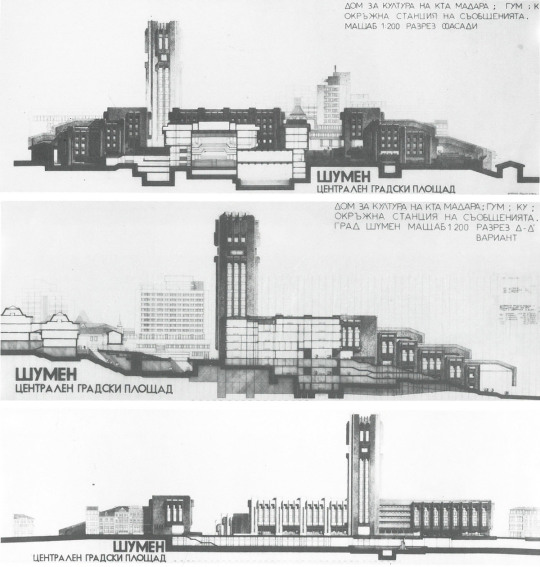
Preliminary (up left) and final (up right) building plan with silhouettes and cross sections (below). | Drawing via Promisljena estetika (1988) Vol. 1
Other outlets inside the building included tobacconists, pharmaceuticals, a panorama café, coffee shops, a luxury restaurant and nightclub for 250 guests. One particular theme that emerges from the interview is Sivrev’s commitment to environmental issues. The building was designed from the ground up with the goal of combatting congestion and pollution in the city; considerations which had been lacking from many of the Party’s previous large-scale constructions. The Shumen project was to feature open green spaces, rooftop gardens and planted terraces. It was planned with the intention of increasing the size of community green areas. Cascading water would provide a pleasantly refreshing spray in hot summers, while a unified public transport hub would free the neighbouring streets from traffic congestion.

A towering concrete skeleton of the complex today. | Photo © Darmon Richter
This effect would be achieved by moving some of the city’s essential functions underground. “The construction of underground levels is a social necessity” states Sivrev as “underground levels bring mass transportation stops immediately next to the city square without creating a conflict between pedestrians and motor vehicles. They improve usage of public transportation significantly and reduce noise pollution and car emissions.”
The first underground level was planned for public transport stations, flower shops, souvenir and jewellery shops, homewares, perfumes, a national lottery kiosk and ticket offices for Balkan airline, BDZ rail company, Avtotransport coach company. The second underground level was intended to feature a car park for 200 vehicles under the square and a space for 250 vehicles next to Georgi Dimitrov Boulevard. Below that, the third underground level would provide a united storage area for servicing all buildings in the square.

Silhouettes and cross sections along the main core axes of the central structure. | Drawing via Promisljena estetika (1988) Vol. 1
The project as a whole reflected new ways of thinking about urban space. There are parallels between Ivan Sivrev’s design and the Radiant City proposed by Le Corbusier in 1930, when he exhibited his design for the perfected future metropolis - a linear city formed of standardised blocks, with underground transit routes reducing the surface traffic to allow for an abundance of green spaces. Each block would take the form of a self-contained vertical village containing shops, laundries, even kindergartens. The architect likened his vision to a living organism, composed of interconnected organs working together in harmony.

Le Corbusier’s proposed extent of the Radiant City. | Photo via Stadtstreicher
“I believe we managed to achieve conceptual synergy between urbanisation and architectural-artistic concepts. The development and its attributed buildings create the necessary conditions and allow for creating a unified architectural organism in which all levels and structures are both spatially and functionally connected. This is the very first such development in Bulgaria and it applies the most advanced principles of underground urbanism” is certain Sivrev. His design sketches show that the plan for Shumen Central City Square would have seen it grow considerably larger than what’s visible today. Much like Le Corbusier’s Radiant City the project would remain unrealised and today, those who venture inside will find not utopia, but a sprawling warren of abandoned spaces and twisting concrete corridors.

Unfinished spaces on the easternmost block. | Photo © Darmon Richter

Plants have taken root in some of the airier regions of the complex. | Photo © Darmon Richter
Bulgaria’s communist leader Todor Zhivkov was kicked out by his own party in 1989 in response to a number of growing criticisms throughout the final years of his regime. The rise of nationalism had been a major factor, culminating in Zhivkov’s attempted ethnic cleansing of Turkish and Roma minorities, beside that there had also been serious environmental concerns. Zhivkov had continued his predecessors’ urbanisation schemes, with large-scale industrialisation as cities were rapidly expanded to accommodate new work forces. The state had done little, however, to offset the effect this was having on the environment. By 1989, The Ledger reported that 85% of Bulgaria’s river water and 70% of its farmland had been damaged by industrial wastes and pollutants.
The Danube city of Ruse had it worst of all, when a chemical plant was built across the river at Giurgiu in Romania, it began to exhale toxic gases towards Bulgaria. Soil around the Ruse area was shown to contain concentrations of mineral acid at 40 times over the safe limit. A cloud of chemical gas descended on a Ruse meeting of the Young Pioneer organisation in September 1987, and children as young as seven were seen choking, running for cover with their red neckerchiefs clutched over their mouths. Zhivkov refused to act, however, unwilling to upset his fraternal relationship with the Romanian dictator Nicolae Ceaușescu. The Committee for the Ecological Protection of Ruse was founded, and they began protesting Zhivkov’s lack of solutions. Initially these demonstrations were crushed, Zhivkov allegedly ordered the beating of a group of environmental activists outside an OSCE summit in October 1989, but national dissatisfaction grew. Organised, nationwide protest gave birth to the Ecological Openness movement: a forerunner to the contemporary Bulgarian Green Party.
As Detlef Pollack and Jan Wielgohs note in Dissent and Opposition in Communist Eastern Europe, “On November 3 1989, Ecoglasnost (Ecological Openness) delivered the crucial blow to the Communist political system. At least 10,000 people came and marched to parliament, carrying posters and chanting the word democracy. It was a crucial breakthrough. Just a week following the Ecoglasnost march, Zhivkov was sacked.”

Bare concrete facades on the north side. | Photo © Darmon Richter

Shumen from the rooftops. | Photo © Darmon Richter
Perhaps Shumen’s Central City Square, a Corbusian city of the future, designed for a new ecologically responsible mode for urban living, had been a belated response to the problems. Perhaps it was intended as a trial, as the first of a new wave of ecologically-friendly urban redevelopments, but even if that were the case it was too little, too late.
Even by 1988, the project had reportedly been fraught with difficulties and by disagreements amongst its creative team. Sivrev explained these as “the inability to comprehend the unity and yet simultaneously multi-faceted nature of the development.” One engineer had baulked at the prospect of building the tower and ran away from the project. “Atypical solutions require atypical thinking” Sivrev concluded.

The unfinished tower. | Photo © Darmon Richter
But the final blow came in 1989 when the communist state was dissolved and Shumen’s Central City Square, like so many other unfinished constructions in Bulgaria, had its funding cut off. In place of a unified architectural organism the people of Shumen would be left instead to deal with a colossal, crumbling skeleton.
--
by Darmon Richter [Adapted with permission from Ex Utopia]
178 notes
·
View notes
Text
Everything I Love About Loser Geek Whatever
So, not too long ago, it was the third birthday of Loser Geek Whatever. Yes, I know the single was released on November 30th 2018 and its considered the song’s official birthday, but the 26th July three years ago was the first showing of the 2018 Off-Broadway revival of Be More Chill and the first time Loser Geek Whatever was shown to the world in any capacity. Therefore, I consider that day to be the song’s unoffical birthday and I’ve been waiting to write down everything I love about it so here I am. (This was originally gonna be posted on the 26th July but I can’t make anything concise so it took longer than that).
I’ve gone on and on about what Loser Geek Whatever means to me personally, how a slew of random chance introduce me to it, got me deep into Be More Chill, introduced me to 90% of my current friends, and overall up-ended my whole life, but now it’s time to dissect the song itself and why it’s so great. As much as I adore Loser Geek Whatever, it could’ve easily been any other song that threw me down a rabbit hole and that I could’ve latched onto- no, wait, it couldn’t have been, because Loser Geek Whatever is unique in that way. I did about a year of music at A-Level so I’m gonna delve into some of the technical aspects here too. I’m chronicling this mostly for myself so I am going as deep as I see fit because this song is a treasure hiding yet more treasures. If you happen to love Loser Geek Whatever as much as I do, this’ll be your goldmine.
So, grab a snack my fellow fans, because here’s a comprehensive list of everything to love about Loser Geek Whatever in roughly chronological order. Long post incoming:
The song starts off strong from the first millisecond - I don’t know what instrument(s) they used but just listen to the single version again - that opening chord blares at you like a siren. It calls for your attention, screaming this is incredibly important, and indeed it is. That chord, an F chord, has no indication as to whether it’s major or minor - it’s just the tonic F with its dominant C and another tonic F above it. In other words, it’s unresolved, it hangs in the air. From a narrative standpoint, Jeremy is at a crossroads, torn between giving into the SQUIP or staying loyal to Michael, and the music paints this. It has the same effect on both the single and album versions - I always hold my breath as it holds, it’s the gap in this crucial transition for Jeremy between who he was and him becoming something he isn’t.
To continue the thread of musical painting, the melody line contains the accidental E-flat which doesn’t belong to the key of F major. This once again illustrates Jeremy’s uncertainty, but there’s more - the whole introduction is a slowed-down version of the Apocalypse of the Damned theme from Two Player Game, arguably the point in the show when Michael and Jeremy’s relationship was at its strongest. Jeremy’s recalling everything he had with Michael, but the slowing down of the melody shows hesitancy, along with highlighting the accidental E flat. These latter points of course aren’t unique to Loser Geek Whatever - they’re also in the section of Upgrade that twins with Loser Geek Whatever. I’m just laying out why they work so well.
I’m glad I waited until after I saw the show in London to finish writing this - I’m something of a Loser Geek Whatever purist, as made clear by my ire at them cutting it in half and tacking the end of Upgrade back on for the London version. I still enjoyed the show in London though and I’m glad I knew about this change ahead of time, because they did change something about the song that I think really worked - they added two notes in the bass to each bar, like heartbeats, which once again signifies Jeremy’s uncertancy and the importance of this major turning point.
It’s been firmly established by this point that Jeremy is a loser and he knows it. He doesn’t want to be a hero, he just wants to survive, but there’s a difference between that and feeling “inconsequential.” Jeremy is basically admitting that, in his eyes, it doesn’t matter to the world or anyone except Michael if he even survives or not. He’s not just a loser, or a geek - he’s a whatever, with no one caring who he is. And he’s felt this way for years - since middle school began. He’s now in his Junior year of high school - that’s five years of being in this state of being unnoticed at best and picked on at worst. He’s “the one who’s left out”. With just one little line, hell, one word, we’re given more layers as to why he so badly wants to change that.
Moving from the first verse to the chorus, we start to see Jeremy’s attitude shift, from being sad to being angry - he’s frustrated, resentful that he’s spent so long in this state (A lot of people have made similar comparisons about Will Roland’s Jeremy as a whole in relation to Will Connolly’s Jeremy and I think this song exemplifies that). He doesn’t deserve to feel this horrible - not now and certainly not for the next two years until he and Michael can be “cool in college.” When you think about it, what options does he really have? He could either give into the SQUIP or reject it and go back to where he was, still miserable and lonely. Yes, he has Michael and Michael is an amazing, kind, loyal best friend, but as many have pointed out, he’s also dismissive of Jeremy’s feelings of inadequacy whether he means to be or not, which only made Jeremy feel more lonely. Should Jeremy just expect to feel better about himself at some point before college? He’s waited for years, why would that happen at any other point?
More layers baby! Second verse, Jeremy rants on about his father’s advice about following his own instincts and how it’s gotten him nowhere he wants to be. Come to think of it, Michael’s advice about staying the same and waiting for their environment to change can be seen as similar - it’s arguably easier for Michael as he has two loving mothers who undoutably give him plenty of positive reinforcement. Meanwhile, Jeremy’s mother has left them, which likely instilled further feelings of not being good enough, and his father has fallen apart to the point where he can’t even put pants on, let alone step up to take care of his son, meaning that Jeremy likely isn’t going to take his advice very seriously, especially after it’s failed him so thoroughly. But to Jeremy, the problem isn’t necessarily the advice itself - it’s that it’s being followed by him. So now he’s going to turn around and put his life and every choice in something else’s hands, even if - no, especially if it goes against his own instincts. It still doesn’t feel quite right, it “feels bizarre”, but it’s getting him somewhere, so it has to be right in the most meaningful capacity, and to Jeremy, the “most meaningful capacity” is any capacity that isn’t his own.
Now the best line - the one about being a “normal, handsome guy”. Let’s get this on the table - Jeremy is trans. Will Roland himself said that he often thinks of the show’s young trans fans when he sings that line. Naturally, societal transphobia plus gender dysphoria would have a pretty catestrophic effect on the self-esteem of any growing teenager, even more so one in Jeremy’s situation for the reasons I’ve just laid out. He’s probably missed out on a lot of things that “normal” guys take for granted, with most girls barely looking in his direction, let alone in any positive manner. Jeremy’s own sexuality aside, it’s mostly society, and the SQUIP by extension, that considers scoring with girls to be a “manly” or masculine activity, and through Brooke treating him as dateable material, Jeremy feels better about fitting into society’s rules of how a man should be and act. This isn’t the only reason he feels good about Brooke finding him attractive, of course, but it’s just another layer that Jeremy sees more value in conforming to how society says he should be rather than in how he actually is.
I know I just said that the last point was about the best line, but honestly, there’s more than one best line in this song. The bridge is where we start to see Jeremy’s language becoming more technologically inclined - “prompt”, “command” and “bandwidth” are all terms used in computing and used to show how Jeremy is likening himself, or his intentions, to a computer, effectivly merging himself and his SQUIP into one entity and Jeremy willingly giving over his own individuality.
And HERE, we get to the kicker. I’ve talked a lot about layers throughout this whole essay, about themes and motifs building on each other. Jeremy is essentially peeling back the layers of his own situation and only finding reason after deeper reason after deeper reason as to why he should follow the SQUIP and not be a loser anymore. Now, he hits the core, the seed, the crux of it all - “The problem has ALWAYS BEEN ME!!” Everything he is, everything that makes Jeremy Heere himself, is and has always been wrong. This line is a gut punch and EVERYONE knows it - the performer always takes a few seconds to let it sink in before continuing.
As an aside, I wanna mention the differences between the single and the album versions of the bridge. The album version starts of quieter after the vocalising of the last chorus, and builds up to the climactic final line, while the single version is loud all the way through but gets even louder and punchier at the end. Both are good, but I personally prefer the single version - the album sounds like Jeremy is broken and desperate and on the verge of tears as he reaches his inevitable but ugly realisation. The single is also desperate, but it’s pleading and all-consuming and a THOUSAND times more powerful, I get chills every time I hear it. (Side note, the London version starts of loud like the single and ends quieter like the album, almost as if Jeremy is reluctant to admit what he truly believes about himself, and it’s easy to see why, it’s a damn harsh condemnation).
“Take a breath and get prepared” - Jeremy sings to both himself and the audience. The first half has been heavy and we need a breather. Yet just before he goes over the brink, he has second thoughts. His conscience, his own voice in his head, breaks through, warning him that his choice will have consequences for other people than himself. People will get hurt - Michael most of all. Not just by Jeremy ditching him; here’s something else - when Jeremy is the “cool dude”, he might end up being a bully to those who are losers just like him, cutting them down just as Rich’s SQUIP made Rich do to him. Who would be the perfect target for Jeremy’s potential future bullying? His former best friend and fellow loser, Michael Mell. It’s pretty damn likely that if the SQUIP hadn’t optic nerve blocked Michael, it would’ve told Jeremy to pick on him, and even though Michael has ostensibly been pretty good at brushing these things off before, the takedowns would hurt a LOT more coming from his former best friend - and we know this because IT ACTUALLY HAPPENS, granted without the SQUIP influencing Jeremy directly (also let’s just clear up that just because the SQUIP wasn’t on doesn’t mean its influence on Jeremy hadn’t disappeared - that’s not how emotional abuse works).
Twelve years of loyal friendship, of borderline unhealthy codependency … can he throw all that away for Christine, a girl he’s thus admired from afar and is only just starting to get to know as a person? Moreover, even if Jeremy gets Christine, what about himself, who he wants to be? He just wants to be something other than himself because he thinks that anything is better but … what? The cool dude, the hero or … whatever. He’ll take anything because he’s that desperate, but what about when he gets it? Will he finally be satisfied? Will it be worth failing his one real friend, an act so scummy that the only way he could possibly stomach it would be to somehow pretend he hadn’t done it?
But none of those questions matter to Jeremy now - he’s fully gaslit into believing that every thought and inclination that comes from himself is wrong and shouldn’t be followed. He needs to sync up with the SQUIP and the rest of the world and mute his own defective inner voice. When you think about it, the relationship between Jeremy and the SQUIP is one of the most intense abusive relationships ever put to fiction - we’ve seen emotional abuse and brainwashing before, but here, Jeremy is literally preventing from THINKING the wrong way because the SQUIP can detect his every thought. See what I mean when I say that doesn’t go away when the SQUIP turns off for a few minutes?!
Throughout all of this is the undercurrent of Jeremy wanting to get better. He’s been trying so hard for so long to have a better life, but nothing has worked. Not listening to his dad, not trying to get closer to Christine through theatre, and certainly not listening to Michael’s advice to wait until college. Why should he resign himself to even more time being miserable with no end in sight? After all, being cool in college isn’t a guarantee. After all he’s been through, it’s his turn to finally be cool, after an eternity of being someone he doesn’t want to be.
Another best line in this song - “I’m Player One.” As mentioned a few times in the show before, like in the Broadway upgrade, Jeremy feels lower even in his friendship with Michael - he’s Player 2 as the more experienced Michael is Player 1. As previously established, Jeremy admits that he’s “not the one who the story’s about.” Now he’s ready to finally take control of his life, be the main character and have good things happen to him, and that means cutting out Michael, the old Player 1. The irony here is that Jeremy is less like Player 1 and more like a video game avatar. In reality, the SQUIP is Player 1, making Jeremy do whatever it demands of him.
More best lines! The slew of insults towards the end serves not just as yet more gut punches for the audience but as a major catharsis for Jeremy - It’s telling that the insults get harsher as his rant goes on, from the “weirdo” to the “weakling freak” to the “failure” to the climactic “please don’t speak”. He’s unloading everything that he’s been carrying over the years, ripping out the bullets that have been embedded in his skin and re-opening all the wounds in the process, but he’s done with the pain and he’ll never ever let himself be hurt like that again, if he follows the SQUIP.
I’ve made a whole post about the significance of the best line “Please Don’t Speak” before so I’ll mostly be repeating a lot of what I said there because it’s been a while since that post and because I want to. Who would’ve said that to Jeremy? Probably not Rich or Chloe, it’s not like them. It had to have come from an adult in a position of authority that could’ve commanded Jeremy not to speak like that - one that apparently did so enough times for him to internalise those words like he did the others. (Even worse if it was more than one adult ...). Out of all of the insults, it’s easy to see how that can easily be the most scarring out of all of them - how would an adult let a child know they’re inadequate? By silencing them. Making it clear that their expression of self not only means nothing, but should be forcibly avoided. Put like that, it makes it much easier to see how and why Jeremy fell under the SQUIP’s influence so easily - telling it was hardly different from authority figures he’s experienced before. In even more sad irony, as Jeremy claims that he’s breaking free and letting go of his past as the “please don’t speak”, he’s just walking right into another, similar trap that he can’t easily escape from. The SQUIP literally vocal cord blocks him during The Play - if that doesn’t say “Please don’t speak,” what does?!
The climax is growing! The music shifts into the relative minor as Jeremy fully gives in to the SQUIP’s evil influence. This is the point of no return, the point where he’s literally being surrounded and overtaken - if you’ve seen this on stage or even just a bootleg, you’ll know what I mean, when the lighting shifts and the circuitry start closing in around him, it’s wonderful. The bass ascends, Jeremy declares once and for all that HE IS NOT THE LOSER, THE GEEK, OR WHATEVER, and he never will be again! As some have pointed out, the sequence of notes on the final “again” is the same as at the end of Be More Chill Part 2, except the last note is different. In BMC part 2, it goes further down by a minor third, but in Loser Geek Whatever, it rises up to the same note it started with. This foreshadows Jeremy’s fate - that he will eventually overcome the SQUIP and that he still has it in him to do so. Man, let me just point out how amazing that last belt is - it lasts for a full 15 seconds in a really high range and takes a LOT of control to bring it back up to the high B without breaking. This song really was written for Will Roland - his voice can pull it off seamlessly, but other actors and understudies have had to find workarounds. No disrespect to them, it’s a damn hard song and it kicks ass all the way through. Scott Folan apparently had trouble with it too, but on the day I happened to see him, he pulled it off without breaking, so props to him!
Overall, Loser Geek Whatever is my favourite song in Be More Chill and not just for its sentimental value to myself. It’s a genuinely deep, complex piece that earned every second of its six minutes. Loser Geek Whatever is definitely the missing piece the show needed - not only is it Jeremy’s solo song, it’s also his “I Want” song and, in a way, his 11 o’clock number all in one, as he’s having a major epiphany after going on a journey, albeit only half of one. It’s easy to see why Joe Iconis dubbed this his anti-Defying Gravity, but it’s also easy to draw parallels to No Good Deed - how both Jeremy and Elphaba vow to become something that society is forcing upon them rather than what they are, even if that society’s will is objectively worse for them. Loser Geek Whatever deserves a thousand times the recognition it has and I still wonder to this day what the fandom reaction would’ve been if it had been in the original soundtrack.
So, that was it. I’m not sorry it was this long.
TL;DR: Loser Geek Whatever is wonderful and anyone who doesn’t think so is wrong.
#be more chill#loser geek whatever#joe iconis#will roland#be more chill meta#music theory#broadway be more chill#be more chill 2.0#be more chill 3.0#musical theatre theory#tw depression#jeremy heere#michael mell#be more chill analysis#tw emotional abuse#trans jeremy heere
56 notes
·
View notes